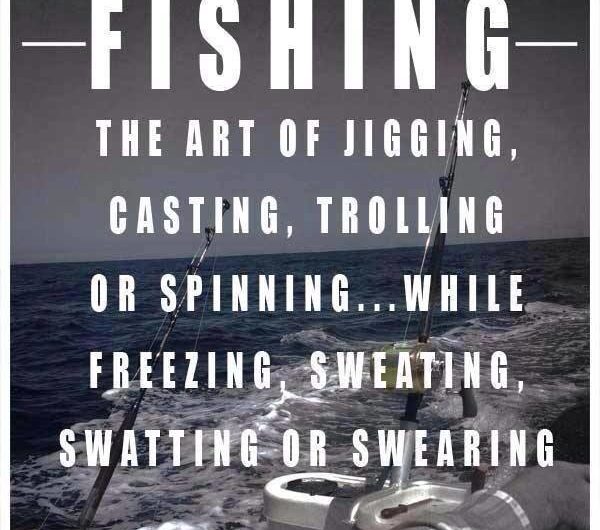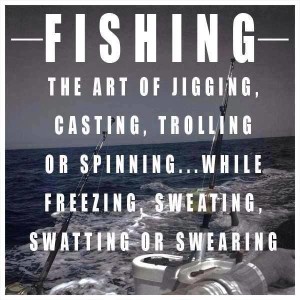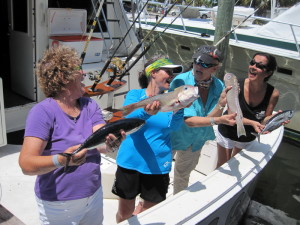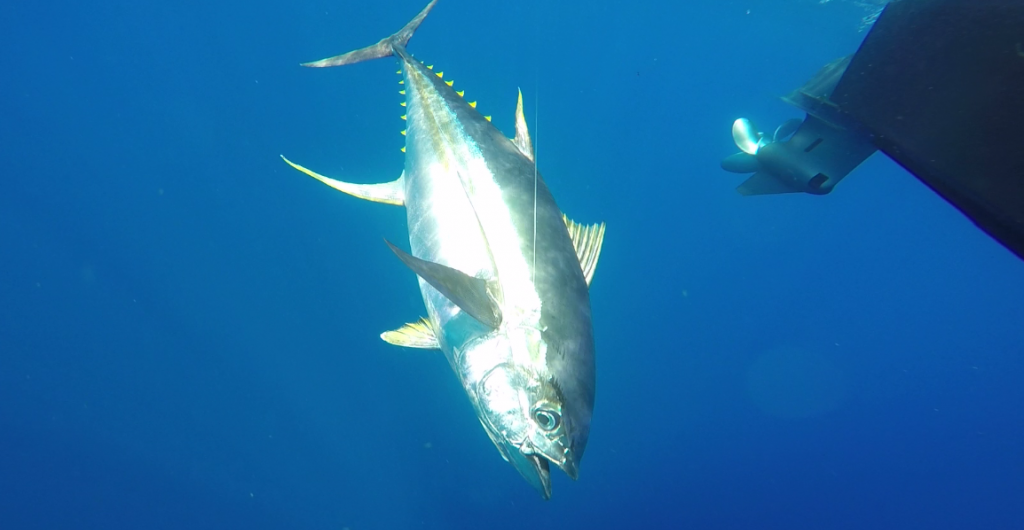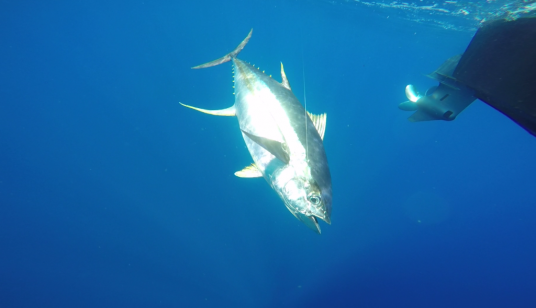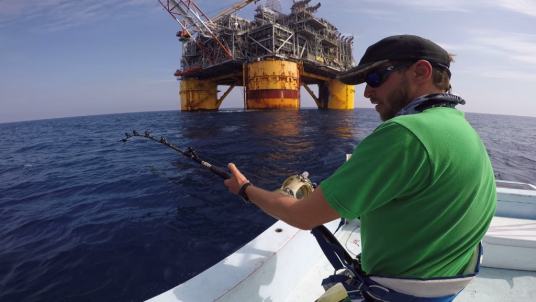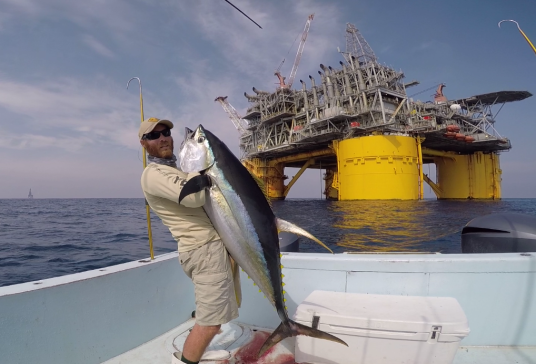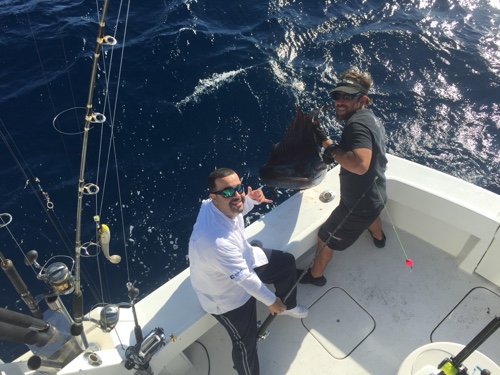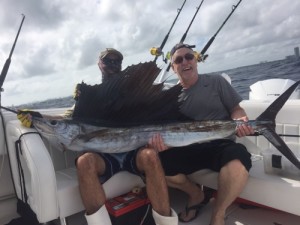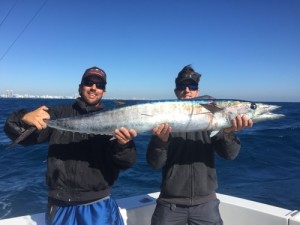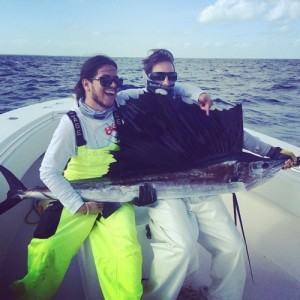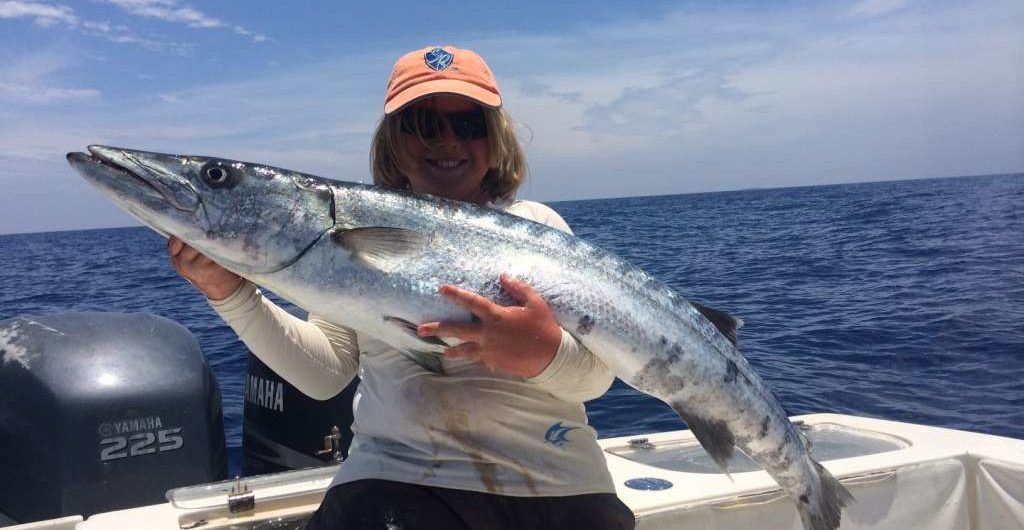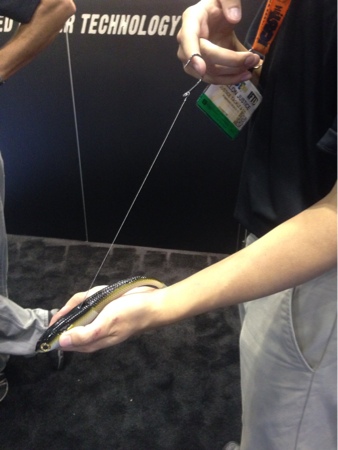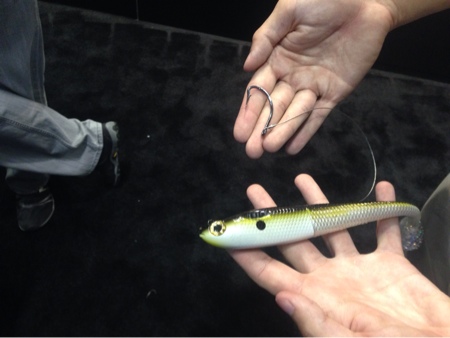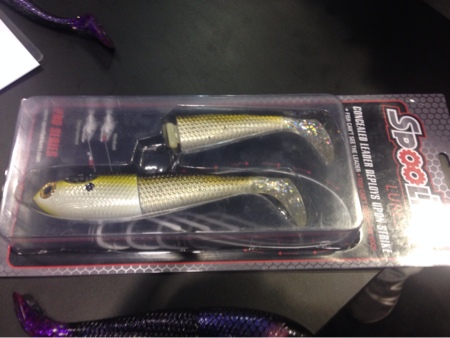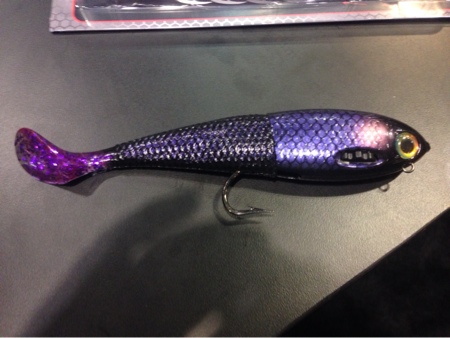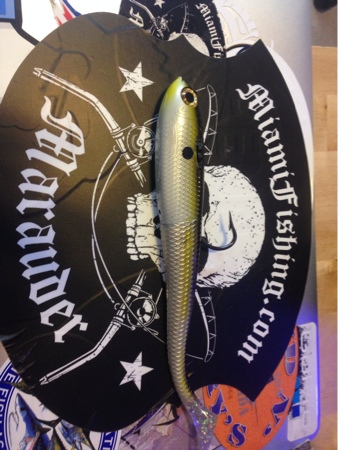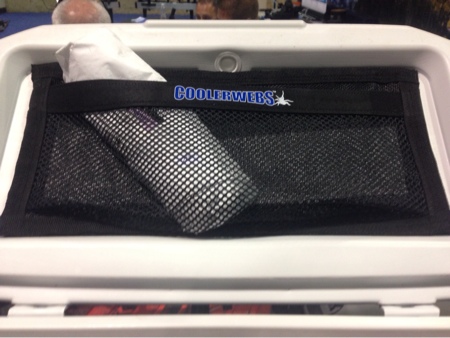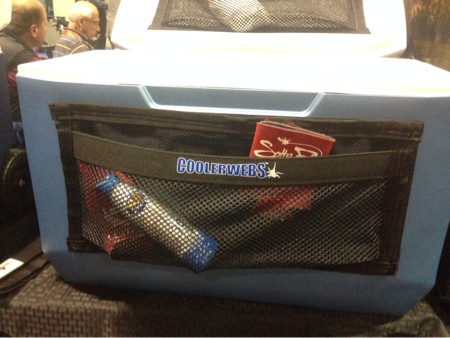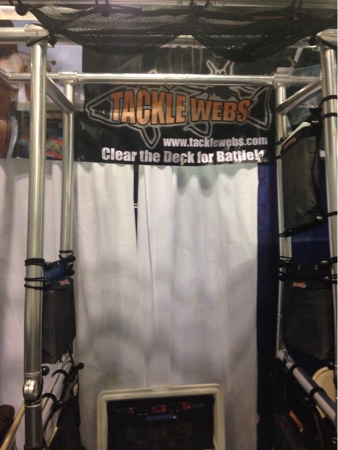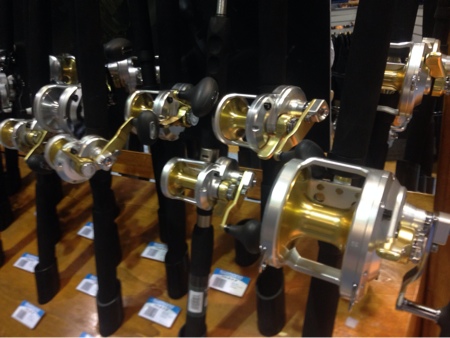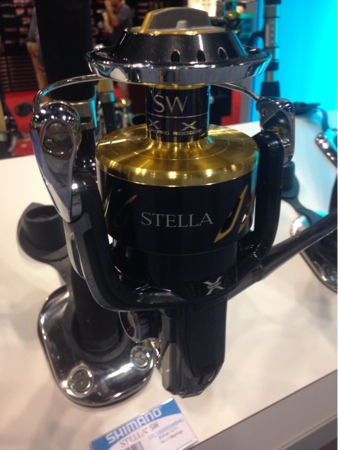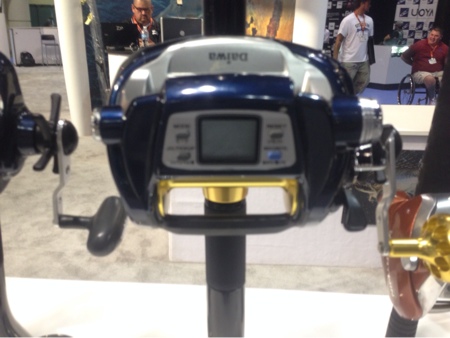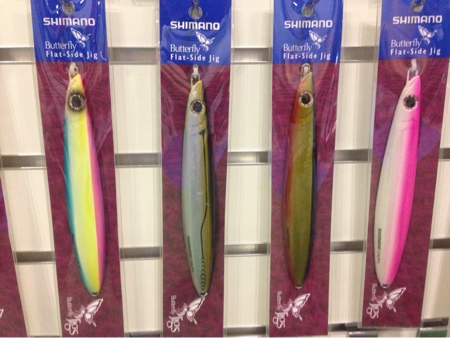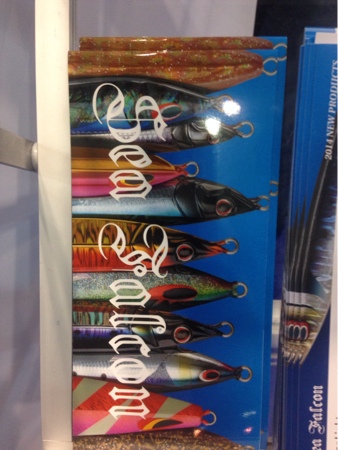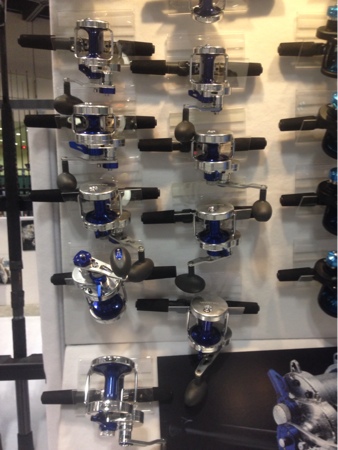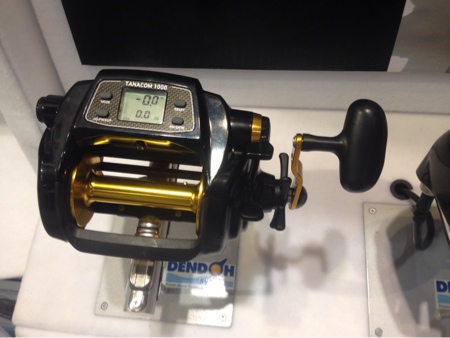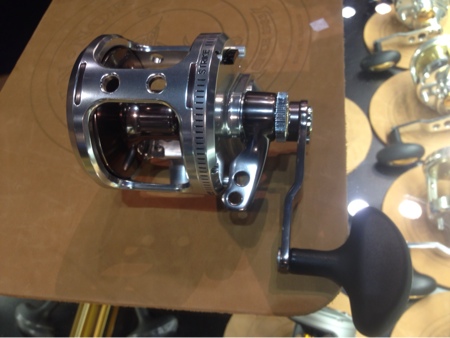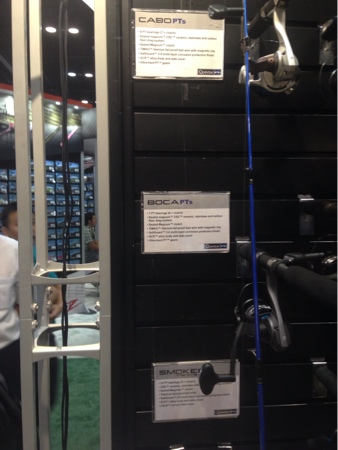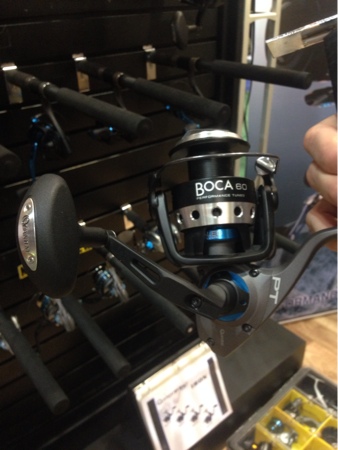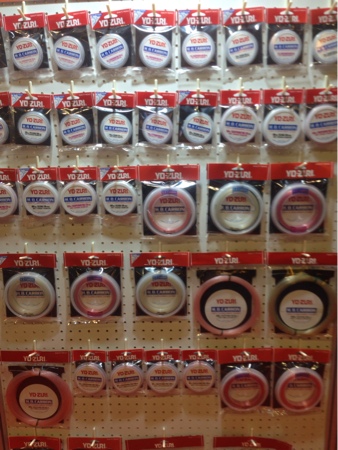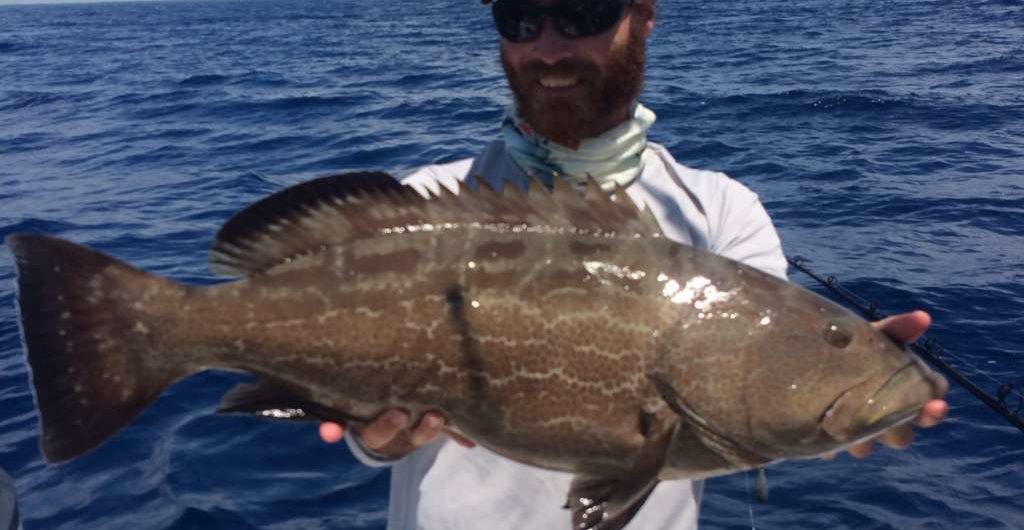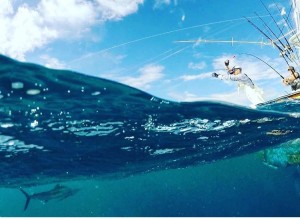
This first week of November has produced great mixed bag days for clients. Sailfish are still biting well, along with the mackerel species. Kite fishing has been very productive for sailfish and the tuna species. Additionally, good numbers of king mackerel and cero mackerel are being caught trolling planers with spoons or bonita strips. Spots are filling up fast, so book now!
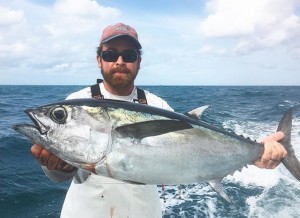
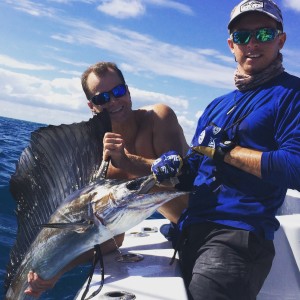
[arrow_feed id=’5026′]
How to catch live bait?
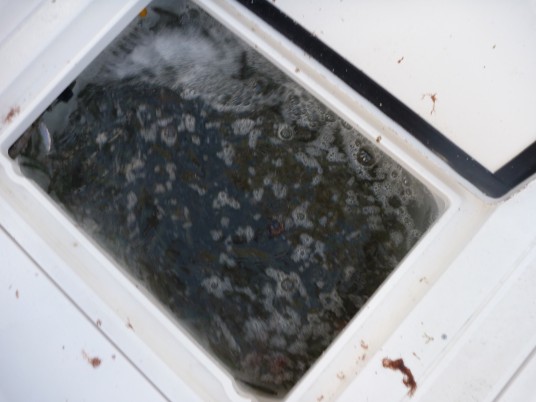
If you’re not fishing live bait on your offshore excursions – to say you are missing out is the understatement of the year. You can only troll dead baits or lures for so long before you lose your mind not catching anything. Lots of fishermen in Miami swear by trolling…they refuse to do anything else, but those poor souls are missing out on what is, by far, the most effective form of fishing in south florida. If you want to catch fish consistently when you’re deep sea fishing – you need live bait. Period. There’s a few options for catching live bait – using sabikis and catching them individually, or throwing a cast net to catch part of a school of baitfish.
Baitfish, like most gamefish in south florida, are highly seasonal. How do you catch live bait?
You catch them with a cast net, or sabikis. Certain times of the year are better than others and at times, you can’t even catch a pilchard if your life depended on it. The purpose of this article is to educate you on the types of baitfish you can catch in Miami waters and the methods you should use to catch them. In case you’re simply looking for a place to buy live bait – we’ve got that too (scroll to the end of the article).
You can catch live bait with castnets from 5-14′ feet in diameter. Learning to throw a castnet is a great skill, but takes experience to be successful. Catching live bait with a net also tends to “beat up” the baits, meaning they will not survive as long due to missing scales, or other damage inflicted while being caught with a net. For the friskiest baits, we prefer to “hand catch” bait with sabikis of varying size. Sabikis are the best way to catch live bait if you don’t have a castnet, and have the time and patience to find them and catch your bait a few at a time.
Buy Sabikis at RandRTackle.com
The most popular baitfish for fishing in miami includes pilchards, threadfin herring, mullett, blue runners, goggle eyes, cigar minnows, and pinfish. These baitfish are available most of the year but certainly have peak seasons. Depending on weather, current, water clarity, temperature, salinity, and oxygen content – these baitfish tend to move around in search of their comfort zone. Bear in mind these baitfish are constantly running for their lives – they seldom hang out in places where they can be ambushed for very long. Knowing where to find them and how to catch them is the challenge you face and is the key to your fishing success.
Pilchards in Miami
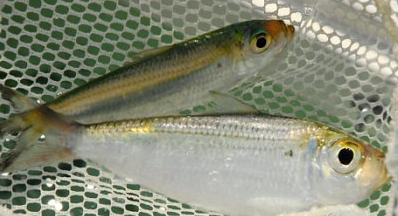
Pilchards are a prolific and popular bait for offshore fishermen. Almost everyone who fishes offshore professionally knows how and where to catch these baitfish – they are a crucial ingredient for catching every pelagic species. Mahi, sailfish, tuna, and wahoo will crush pilchards any chance they get. Pilchards are also very hearty baits and can survive a long time if you’re gentle when rigging them and are careful about keeping them in the water. While they are prone to injury, they are perfectly frisky and flutter spastically in the water. They are never found solo and tend to swarm over grassy areas in large schools. Pilchards will swarm a chum bag if you find a hungry school and can be caught with small sized sabikis. Wherever the pilchards roam, cudas and bonitas usually aren’t far behind. When catching pilchards with sabikis, its common to get cut off and lose multiple baits or rigs. When the pilchards are schooled up, throw a cast net and you’ll undoubtedly land a dozen or more at a time. Pilchards that are caught in a net usually don’t live as long as pilchards that are caught with a sabiki – as i mentioned they are prone to injury and sensitive to being crushed. It is absolutely crucial that you have a well aerated live well to keep them alive…buckets with bubblers won’t cut it. Pilchards burn lots of oxygen and have a brisk heart rate…they need to be kept in fresh recirculating water to remai at peak condition. Most pilchards you catch in miami will be small, but in the spring and early summer its common to catch them as large as 4″. Pilchards make excellent offshore baits because they can be rigged through the nose, which is quite sturdy. They cast well and swim deep after hitting the surface. If you find yourself in a school of dolphin or frenzied tunas – pilchards are a sure fire way to keep the fish at the boat.
Threadfins in Miami
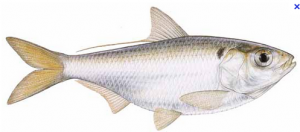
Threadfin herring migrate through in the winter months but can be caught during most of the year around structure where the current is moderate. They are large frisky baits that sailfish and large pelagic fish just can’t pass up. A well full of threadfin herring ensures a good day fishing, but these baits are the most sensitive of the bunch. Herring are notoriously weak fish, they can’t live for more than a few seconds out of the water. While sailfish experts can bridle rig a threadfin in just a few seconds, you’re average angler will choke the fish to death long before that happens. They are also delicate and cannot be crushed. When the opportunity presents itself to cast net a large school of herring, the baitfish usually won’t live more than 24 hours. Threadfins feed best when chummed up in current, and can be caught with small sabiki rigs. They are super frisky, which means if you hook a stringer its important to reel quickly so they don’t swim in circles and get fouled up. Threadfin herring also make excellent cuts baits as they are very oily and leave a scent trail. Their large size makes them poor dolphin baits, as schoolies will grab them but can’t swallow them whole. Bonitas, Kingfish, wahoo, and lots of pelagic predators will crush a frail threadfin at any chance. Threadfins also swim along the surface when free lined or flat lined, which makes them excellent surface baits. Because these baits are big and broad, they do tend to spin when hooked through the nostril, which makes slow trolling them a challenge. Threadfins are best for kite fishing or flat lining, but also make excellent bottom fishing baits. Their helplessness and frantic fluttering makes them attractive to reef dwellers in search of an easy meal.
Mullett in Miami
Mullett are the absolute go to bait for just about anything. They can only be caught by cast net when schooled up but are some of the hardiest baits you can get. Their weight and bulk make them easy to cast and their endurance is second only to goggle eyes. Mullett require very little oxygen to survive, which means they can live in poorly oxygenated baitwells or buckets for quite a while. Cobia, kingfish, and even sailfish will chomp a mullett found swimming in the bluewater. Mullett are also the absolute best tarpon bait you could hope to acquire. Mullett are usually found inshore, in canals, marinas, creeks, mangrove islands, and channels. When they migrate through in the fall, they can be targeted in massive schools and easily captured. Mullett can live in a bait well for up to a week, if not longer, and will flap till their hearts give out. Small sized mullett, also called finger mullett, make excellent dolphin baits. Sometimes referred to as “gummy bears”, finger mullett are the bait of choice alongside pilchards when you find floating debris offshore. If you’re targeting groupers, amberjacks, or other stubborn reef dwellers, a helpless mullett rigged on a finder rig is a sure fire bet. Few groupers and large snappers can resist a fluttering mullett twitching across the sand. Mullett also make exceptional cut bait, but should be fished live offshore if possible.
Blue Runners in Miami
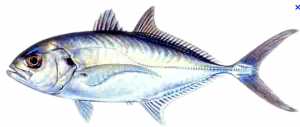 While they’re a far cry from Goggle eyes, blue runners are readily available on the reefs, rock piles, markers, and channels around Miami. They are always hungry and can be caught with medium sized sabikis while chumming. When pilchards, threadfins, and goggle eyes won’t cooperate – blue runners will save the day. They are frisky baits that can be bridle rigged or flown on a kite. Their size makes them formidable swimmers and hardy alternatives to weaker baitfish. Offshore, small to medium sized blue runners are the go to bait for BIG dolpin. Large blue runners are even used for swordfishing when drifting baits near the surface. For the most part, you can catch blue runners year round – they love structure and every fish that swims loves to eat them. Kingfish and Wahoo will crush blue runners that are flat lined or trolled on a planer board…drop one down over a wreck and you’ll surely draw a bite from an amberjack or almaco. While blue runners are superior in strength to herring and pilchards, they can wear out fast if fished on a kite or slow trolled. It is best to live line blue runners with a little bit of weight to get them down below the surface. In most instances, it’s best to use wire and a trailing treble hook as toothy pelagic fish will cut them in half long before engulfing them whole.
While they’re a far cry from Goggle eyes, blue runners are readily available on the reefs, rock piles, markers, and channels around Miami. They are always hungry and can be caught with medium sized sabikis while chumming. When pilchards, threadfins, and goggle eyes won’t cooperate – blue runners will save the day. They are frisky baits that can be bridle rigged or flown on a kite. Their size makes them formidable swimmers and hardy alternatives to weaker baitfish. Offshore, small to medium sized blue runners are the go to bait for BIG dolpin. Large blue runners are even used for swordfishing when drifting baits near the surface. For the most part, you can catch blue runners year round – they love structure and every fish that swims loves to eat them. Kingfish and Wahoo will crush blue runners that are flat lined or trolled on a planer board…drop one down over a wreck and you’ll surely draw a bite from an amberjack or almaco. While blue runners are superior in strength to herring and pilchards, they can wear out fast if fished on a kite or slow trolled. It is best to live line blue runners with a little bit of weight to get them down below the surface. In most instances, it’s best to use wire and a trailing treble hook as toothy pelagic fish will cut them in half long before engulfing them whole.
Buy Sabikis at RandRTackle.com
Goggle Eyes in Miami
There is no bait in Miami waters that rivals the awesomeness of the Goggle eye. The baits are big, frisky, shiny, and olympian swimmers. They are radiant with color and flutter with panic when fished from a kite or on a down rigger. Catching them is difficult as they feed principally at night and retreat to reefs and rockpiles during the day. Their amber color and prismatic skin acts like a beacon to pelagic species. Fishing with Goggle eyes is a sure fire bet to catch anything in the immediate area. It seems that every predator knows when a goggle eye hits the water. During sailfish tournaments, goggle eyes are the most sought after bait in South Florida. Bait boats can make a killing selling goggle eyes to tournament fishermen and weekend warriors – sometimes fetching as much as $100 a dozen! Goggle eyes tend to school with blue runners, jacks, lady fish, and a variety of other inshore species that feed on whatever’s available. It’s best to chum for goggle eyes on structure in the early morning hours, using large sabikis or tiny jig heads with a gold hook. They fight just as hard as blue runners on bait fishing tackle but never lose strength when removed from the water. Goggle eyes must be kept in well aerated live wells but can survive in a bait pen for up to two weeks if fed (and if current exists). Again, there is simply no beter bait for fishing in Miami than a goggle eye. Kingfish, sailfish, wahoo, tuna, cobia…well, anything that swims will crush a goggle eye. We’ve even put it to the test fishing midwater rods with a variety of baits and the goggle eye ALWAYS gets hit first. It’s actually pretty amazing. I consider the goggle eye to be the filet mignon of baitfish. They are truly the best live bait you can get. .
Cigar Minnows in Miami
 These tube like baitfish are an outstanding alternative to pilchards and threadfins. They are strong durable baits which can live for a long time in a well aerated baitwell. They are somewhat shy of sabiki rigs but can be chummed up into a frenzy. Cigar minnows are always available and can be found on rockpiles, patch reefs, markers, and assorted offshore structure. While they can’t be dip netted or cast netted, you can load up on them quickly using sabiki rigs. They are not shy of the boat or the chum and will school up right at the boat if the conditions are right. While you may only pick up one or two at a time, investing an hour to catch a few dozen cigar minnows will prove to be well worth it. Cigar minnows are dolphin candy. They also make excellent mid water and flat line baits. Because they are small and tube like, nearly every fish can eat them without trouble. Cigar minnows are not the best kite baits, but they can save the day in a pinch. They are also a relatively acrobatic baitfish – when rigged through the nose they will hop around on the surface trying to get free. That behavior send a strong signal to predators lurking down below that free meal awaits them. In order to really catch cigar minnows, its best to spend the time exploring patch reefs and markers when the current is strong. You will need plenty of chum to get them to the boat and jigging with a sabiki rod won’t help! Hold the sabiki right in the cloud of chum and wait for a cigar minnow to grab the hook. Lift them out of the water and get them into the well quickly to avoid losing them. Cigar minnows slip free from sabiki hooks better than any baitfish that swims!
These tube like baitfish are an outstanding alternative to pilchards and threadfins. They are strong durable baits which can live for a long time in a well aerated baitwell. They are somewhat shy of sabiki rigs but can be chummed up into a frenzy. Cigar minnows are always available and can be found on rockpiles, patch reefs, markers, and assorted offshore structure. While they can’t be dip netted or cast netted, you can load up on them quickly using sabiki rigs. They are not shy of the boat or the chum and will school up right at the boat if the conditions are right. While you may only pick up one or two at a time, investing an hour to catch a few dozen cigar minnows will prove to be well worth it. Cigar minnows are dolphin candy. They also make excellent mid water and flat line baits. Because they are small and tube like, nearly every fish can eat them without trouble. Cigar minnows are not the best kite baits, but they can save the day in a pinch. They are also a relatively acrobatic baitfish – when rigged through the nose they will hop around on the surface trying to get free. That behavior send a strong signal to predators lurking down below that free meal awaits them. In order to really catch cigar minnows, its best to spend the time exploring patch reefs and markers when the current is strong. You will need plenty of chum to get them to the boat and jigging with a sabiki rod won’t help! Hold the sabiki right in the cloud of chum and wait for a cigar minnow to grab the hook. Lift them out of the water and get them into the well quickly to avoid losing them. Cigar minnows slip free from sabiki hooks better than any baitfish that swims!
Pinfish in Miami
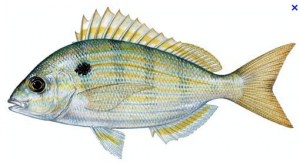 These frisky little perch-like baitfish are one of the best cobia baits available. Pinfish live on grass patches and are voracious eaters. They can be caught with sabiki rigs, cast nets, and will even hit small jigs tipped with shrimp or squid. Pinfish can grow to be the size of your hand and are grouper candy. They are excellent bottom fishing and wreck fishing baits, but seldom draw strikes from pelagic species like dolphin (mainly because pinfish live inshore and never ever venture offshore). Pinfish are extraordinary baits for tarpon, snook, redfish, and grouper…but aren’t so hot for dolphin or pelagic species. We’ve literally had dolphin turn up their nose at small pinfish when that’s all we happened to have in the well. Its best to keep a few pinfish for reef fishing or when the cobia move through. Otherwise, use pinfish for tarpon and snook in cuts or channels.
These frisky little perch-like baitfish are one of the best cobia baits available. Pinfish live on grass patches and are voracious eaters. They can be caught with sabiki rigs, cast nets, and will even hit small jigs tipped with shrimp or squid. Pinfish can grow to be the size of your hand and are grouper candy. They are excellent bottom fishing and wreck fishing baits, but seldom draw strikes from pelagic species like dolphin (mainly because pinfish live inshore and never ever venture offshore). Pinfish are extraordinary baits for tarpon, snook, redfish, and grouper…but aren’t so hot for dolphin or pelagic species. We’ve literally had dolphin turn up their nose at small pinfish when that’s all we happened to have in the well. Its best to keep a few pinfish for reef fishing or when the cobia move through. Otherwise, use pinfish for tarpon and snook in cuts or channels.
Where to Buy Live Bait in Miami
Catching bait can be a big time pain in the ass, especially when several boats are scrambling to wreak havoc on a terrified school of pilchards. Whether you’re having trouble catching bait yourself or you would rather just pay the piper and spend more time fishing – buying bait is relatively easy in Miami, Florida. Bait boats tend to congregate at a handful of locations around Miami. The bug lighthouse, government cut, the entrance to stiltsville, and bayside marina are the most common places to find them. In the mornings, you can call on radio channel 80 or 72 and the closest bait boat will chime back. Expect to pay anywhere between $40 and $100 for live bait depending on what you need. Because bait is seasonal and demand for bait is incredibly high on fridays, saturdays, and sundays – be sure to call ahead and make arrangements with a local bait fishermen. Don’t plan your day on buying bait…consider it a luxury. Always have a game plan for catching live bait if the bait boat is sold out or simply couldn’t find the baitfish that morning. Baitfishing is still fishing – so don’t expect even the best bait captains to have hundreds of frisky pilchards ready to go at 6a.m.
Buy Sabikis at RandRTackle.com
The easiest way to accomplish this is with ACO Live Bait
near Key Biscayne & Govt. Cut.
Call Ariel and ask for the “marauder special”
305-496-9140
or channel 80.
The most reliable, skilled, and famous bait fisherman in Miami is Jimmy Lewis – also known a Kite Hunter. Capt Jimmy is your go to resource for frisky gogs and fresh caught pilchards. He can usually be found trolling near Bug Light most mornings…almost always on fridays, saturdays, and sundays – but also frequent government cut. It’s best to call him on his cell phone in advance of your trip to see what bait wlll be available and if he can meet you on your way offshore. Capt Jimmy is in demand for bait at all times – so don’t expect special treatment. Be early – always give a respectable tip – and don’t be rude. Jimmy fishes hard and does his best to provide bait for dozens of boats every week! You can reach Capt. Jimmy on his cell phone at 305-725-8807 or call on VHF channel 80a.
The Northeast winds continue, and the bite is far better than anyone could have predicted for October. Many boats have caught double digit numbers of sailfish this last week, which is far better than the norm for this time of year. We continue to catch mahi-mahi with some fish weighing up to 25 lbs. Additionally, the light current over the reef has allowed for some great days of bottom fishing. The vermillion and mutton snappers are biting well, over the rocky ledges and live bottom. Fishing is only getting better each day, and we anticipate it to do so over the next several weeks.
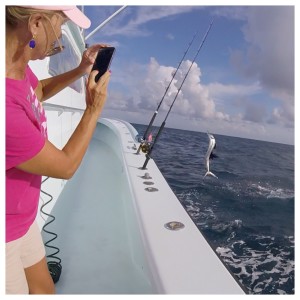
October has been a great month so far for both sailfish and mahi-mahi. As fall approaches, it brings relief from the stagnant days of high heat and humidity. Moderate north east winds have brought the mahi in close to shore, while turning on the bite over the reef. We’re having multiple shots at sailfish each trip, especially when winds allow for kite fishing. King mackerel are also starting to show up in numbers and can be targeted trolling planers and live baiting. Bottom fishing has produced some great yellow-eye and vermillion snappers as well. As water temperatures cool, we expect the fishing to improve over the next several weeks as fish make their annual migrations south for the approaching winter.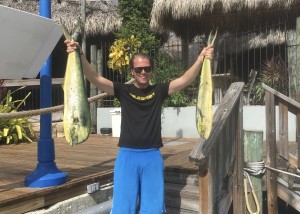

As per most things, I procrastinated on this post far longer than I should have. I talked with Betty Bauma n a few years ago at a marketing conference in Fort Lauderdale (SFIMA), and great lady that has helped train and teach over 8,000 female anglers (mostly in florida), and has a passion, dedicated to helping lady anglers learn how to catch more fish.
n a few years ago at a marketing conference in Fort Lauderdale (SFIMA), and great lady that has helped train and teach over 8,000 female anglers (mostly in florida), and has a passion, dedicated to helping lady anglers learn how to catch more fish.
The Ladies Let’s Go Fishing passion, has allowed Betty and team to volunteer time to teach women to fish as a part of their non-profit organization through the assistance of wonderful volunteers, and sponsors who donate excellent prizes, and fishing trips to help get a few more women tying knots and fishing in florida (and elsewhere). If you know a lady in south florida that would like to learn to gaff her fish, tie some hooks, or rig a ballyhoo, call to get setup for a great weekend of education and fishing.
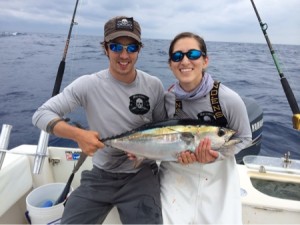
 MiamiFishing.com friends get a discount off already low scholarship rate of $69 while it is still available.
MiamiFishing.com friends get a discount off already low scholarship rate of $69 while it is still available.
Use coupon code SAVE10 to get $10 off!
On Friday is a welcome reception 6-8 pm with appetizer contest and silent auction.
On Saturday from 10 – 4:30 are offshore and inshore fishing classes and hands on skill practice with captains including casting, knot tying, gaffing, releasing, lure usage, conservation, trailer backing and more. A great chance to get one-on-one with the captains!
Sunday offshore fishing optional/extra. It is ok to register a male guest or teen, too.
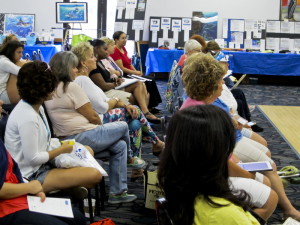 Event is held at I.T. Parker Community Center, Dania Beach, FL, not far from Ft. Lauderdale airport. Register in advance online and check out the online auction, open to e-bids currently at www.ladiesletsgofishing.com. Fees vary depending upon time of registration but start at $69, fishing additional. This is one not to miss – the only South Florida event for this fabulous organization!
Event is held at I.T. Parker Community Center, Dania Beach, FL, not far from Ft. Lauderdale airport. Register in advance online and check out the online auction, open to e-bids currently at www.ladiesletsgofishing.com. Fees vary depending upon time of registration but start at $69, fishing additional. This is one not to miss – the only South Florida event for this fabulous organization!
Phone: 954-475-9068.
Email info@ladiesletsgofishing.com
Call Betty to get signed up for the no yelling educational school of fishing.
Learn all about fishing at the skill stations with well known florida fishing captains.
Including
- DE-HOOKING FISH & INSHORE LURES
- GETTING TIED UP IN KNOTS – MULTIPLE STATIONS
- BALLYHOO RIGGING
- RIG UP YOUR NEW ROD
- HOW TO USE OFFSHORE LURES
- ROD & REEL MAINTENANCE – 4 Reel Services Peter Bilardello
- TYING LINE TO CLEAT AND MORE – Freedom Boat Club of South Florida
Marina and Outdoor Skill Stations (second)
- SPIN CASTING with Penn Reels
- FLYCASTING
- LANDING AND RELEASING (Gaffing Grapefruits)
- NET CASTING
- BOAT HANDLING WITH RANGER BOATS! (based on conditions)
- TRAILERING TECHNIQUES – Practice backing your tow vehicle and trailer, with MAGIC TILT TRAILERS
On Facebook “Ladies, Let’s Go Fishing!”
http://twitter.com/billfishbetty
954.475.9068 o. | 954.474.7299 f.
How do I even tell this story? Of all the tuna fishing expeditions we’ve made the last few years, this might have been the pinnacle of our journeys to the Gulf of Mexico. The secret is out – sportfishermen around the world have heard tales of giant yellowfin tunas blasting baits in the shadows of deep water oil rigs and back breaking fights which cripple men who are unprepared for the strain of titan class tunas.
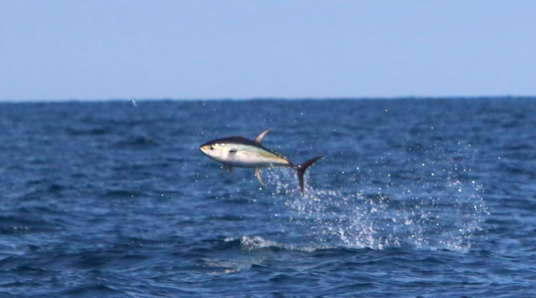
Venice, LA sits at the shores of a bountiful and largely untamed bluewater eden – the culmination of tuna angling in the United States. For us, giant yellowfin tuna fishing in The Gulf is an odyssey into a sport fishing legacy which has been carried by the crew of Paradise Outfitters in Venice, LA for more than a decade.
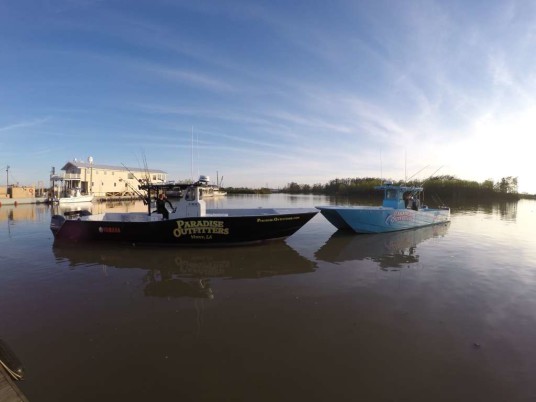
Our previous expeditions with Capt. Hunter Caballero and Capt. Scott Leger put us on the line with 145lb tunas crashing cull behind shrimp boats and chunking for 60-80lb tunas at the midnight lump. They are stories best told with pictures than words -adventures that have evolved into enduring memories which compel us to return, over and over again, to the deep water rigs – in search of that perfect moment, where in a fit of fury, impeccable bluewater predators humble us with their strength. There is no greater battle, no greater reward, than fighting these fish in their element with some of the finest gear on the planet.
Our pilgrimage to Louisiana landed us in the heart of New Orleans late in the afternoon, two days before St. Patricks day. Tourists from all over the country, adorned in green shirts, fo-gold chains, and purple beaded necklaces, clogged the entrance to one of our favorite culinary sanctuaries upon arrival – the Harbor Seafood and Oyster House. Despite the agonizing 35 minute wait for a dose of NOLA fried goodness, patience delivered us to a fitting meal of swamp platters before our commute to the lower delta.
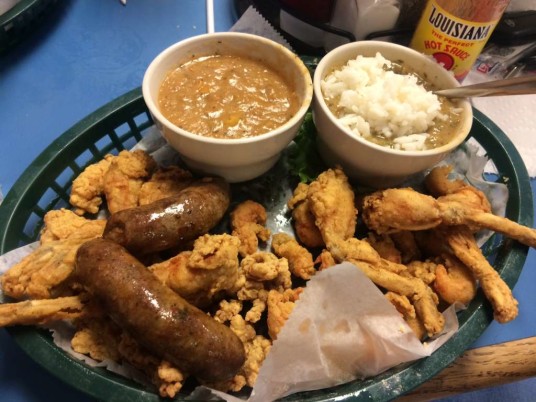
The trip to Venice, LA is a tour through the country side – long stretches of low country road unimpeded by the droves of cars which pour into and out of New Orleans every day. Our late afternoon arrival and swap platter feast put us into Cypress Cove Marina shortly after 7:30, which meant darkness, mosquitos, and a fitting hike out to the new luxury house boat which shelters the crew of Paradise Outfitters.
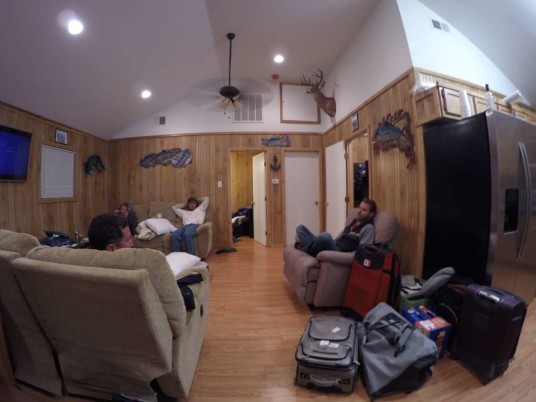
An oasis of a private sport fishing lodge, the house boat is unlike any I have previously encountered. Once inside, you’d never know you weren’t in a downtown condo in anywhere USA. Adorned in a few reminders of trophy fish, scattered foul weather gear, and coolers -the boat itself sported three bedrooms, a full kitchen, dining area and lounge. What was perhaps most striking about the operation is that the entire Paradise Outfitters fleet was docked immediately on, well, the front porch. This is the design and incarnation of charter fishing fantasy – to have your boat, loaded and ready, just ten steps from your front door. That would be torture in almost any other lifestyle.
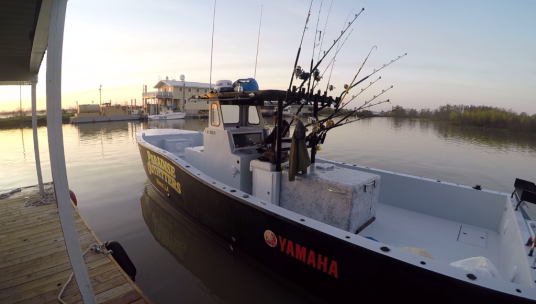
Day 1 – The New Boat and Top Water Tunas
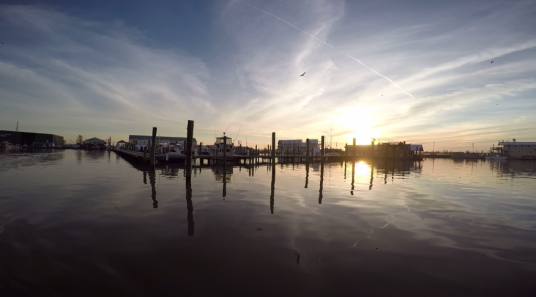
Dawn on the Mississippi is entrancing. Icy river water meets piercing sun, which casts an eerily timeless fog across the harbor. The ominous roar of tankers making their way up and down the tumultuous currents of the Mississippi reverberated through the dock-house as the crew made ready for departure.
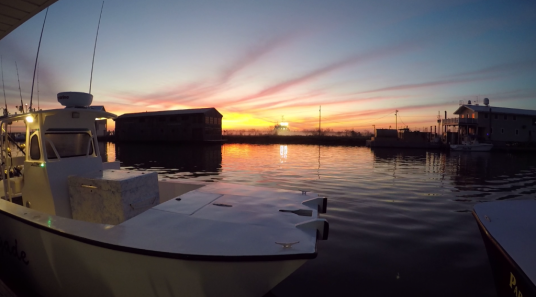
0700 is an on-time start for the PO crew, whose customers wait with tremendous anticipation to begin their journey. As a fitting start to our expedition, we had the privilege of joining Capt. Hunter aboard his brand new 41′ Fin Cat.
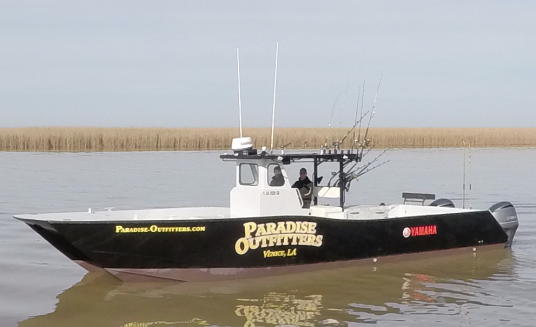
The boat is massive, commanding, and resembles a vehicle more fit for amphibious assault by Seal Team Two than a fishing vessel – but it’s performance is undeniable. It’s hard to appreciate just how enormous and perfectly designed this boat is until you experience it in person.
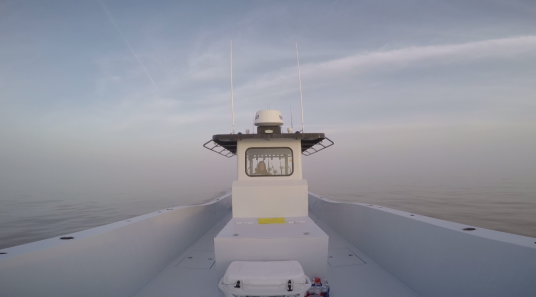
This is the successor to Hunter’s original Fin Cat – boasting a slightly larger control console and a few performance “enhancements” following lessons learned running the original blue boat more than four seasons.
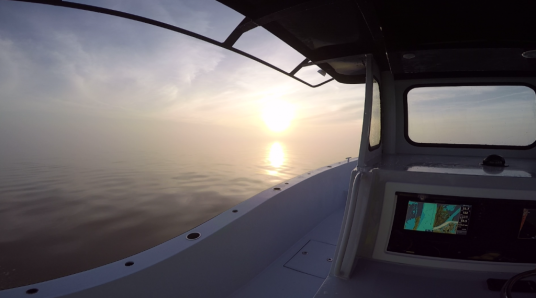
We charged down the Mississippi through a frigid wash of mud stained water, chopped lilly pads, and logs – carried down river from the voluminous thaw of northern snow. 40 degree water temperature at 715 in the morning was a chilling reminder of the harsh winter that crushed most of the U.S the past few months. We passed a variety of tankers just arriving from an enduring ocean journey as we made our way to the pass – many of them casting a brilliant silhouette in the fresh dawn.
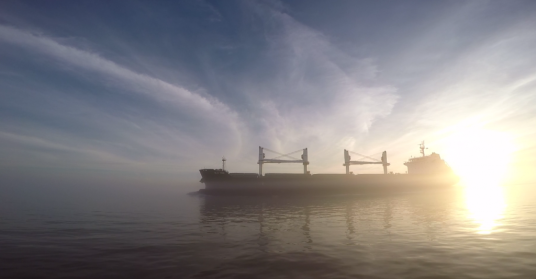
As the sun rose and gave way to warmth, we arrived to the mouth of the river and passed, unobstructed into moderately calm seas.
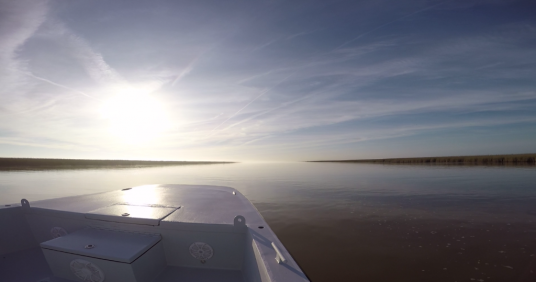
Our last several expeditions with the Paradise crew put us into steep chop which made navigation challenging on the 40 mile run to the floating deep water rigs. Thrilled at the concept of finally fishing in agreeable weather – our plan was simple. Find giant tunas, and catch them on top water plugs.
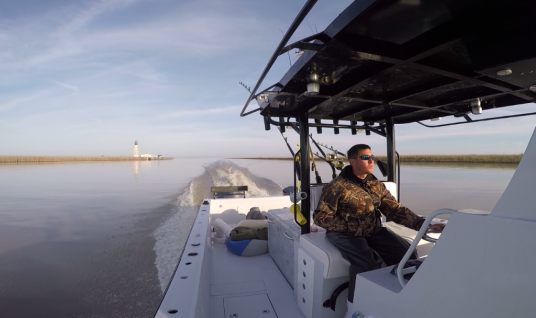
One of Hunter’s shining accolades is his infallible ability to find fish when the odds are stacked against him. Day after day, after day, after day – Hunter finds the bite for his clients. You would be hard pressed to find another Captain as seasoned and well versed in the techniques of catching trophy fish in the seemingly bottomless Gulf of Mexico. What’s most amazing about fishing in The Gulf is the staggering absurdity of the landscape. 40 miles out of the pass, towering in the distance are, for all intensive purposes, what look like space stations on the horizon. The presence of these super structures is visually overwhelming – a solemn reminder of the machines which power the world with petroleum. The contrast of bluewater against these titanic hulks of steel, aluminum, iron, and cable is unnerving as much as it is surreal. The bounty of life which thrives in the shadows and coils which descend from the rigs is nothing short of confounding.
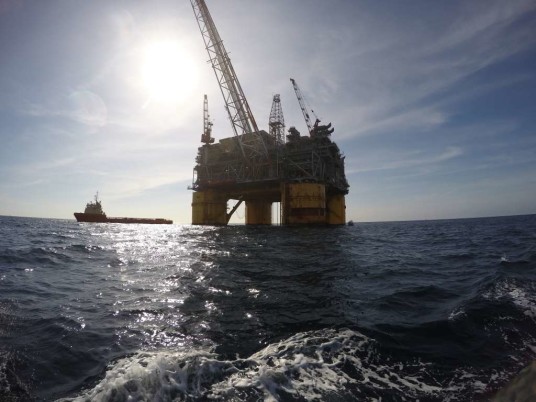
We arrived to the rig under sunny skies, pleased to find bait swimming on the surface and tunas lurking below. Marking yellowfins upon arrival to a rig, as clearly as Hunter’s Simrad’s do, instigates a cascade of emotions which can best be described as one part anxiety, one part pain, and one part melt your face off excitement. To know our quarry is just a few hundred feet below, actively prowling for food – well, that’s something which you need to feel to understand.
We began a broad side drift, slowly chunking our way across the North side of the rig with blackfin tuna for bait. As if on queue during our first drift of the expedition, the line snapped out of my hand, went tight for a split second, then slack. I had missed it. The first bite of the trip, and I had missed it. Defeat. A sensation which is familiar when tuna chunking. A swift decisive transition from free spool to strike on the drag lever is mandatory in order to drive the circle hook home. It’s a technique which takes some practice – and after you miss the bite of what could be a legendary tuna – you repeat the process to yourself over, and over, and over again – until it becomes instinctive. On the second set, we welcomed the first fish to the boat – a smaller specimen which earned a trip to the ice box after a quick, albeit stubborn fight, to the surface.
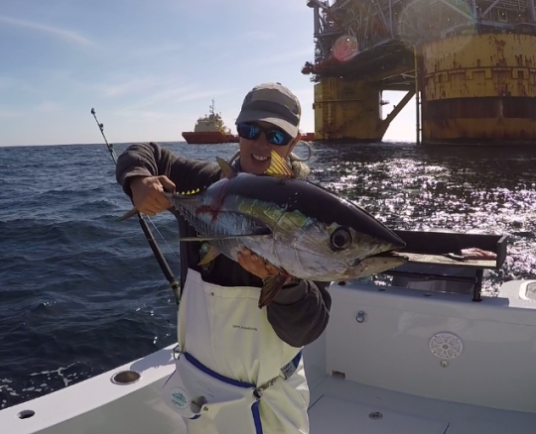
In quick succession, the bite begin to pick up – and a few more small tunas came to the boat. Scott landed our first keeper of the day, boating a nice 30lb fish fit for the dinner table. Into the ice with the fish and then, in one of those fleeting moments where time goes “slow mo” I saw what would ultimately become our destiny that day – an enormous bust. Disbelief, followed by mlld panic, as another bust gave way to a hulking fish hurling itself through the air. My mind didn’t exactly process what I was seeing as a shower of ballyhoo exploded about 150 yards away, followed by an eruption of hundred pound tunas in hot pursuit. Explosion, after explosion, after explosion.
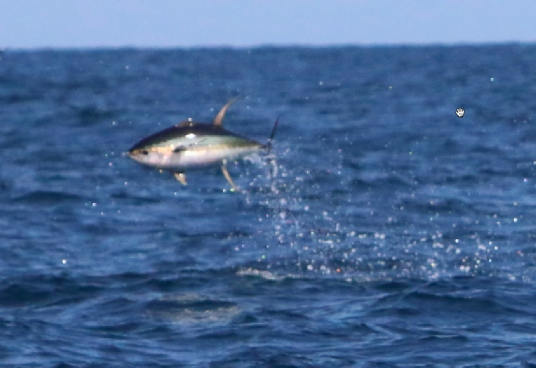
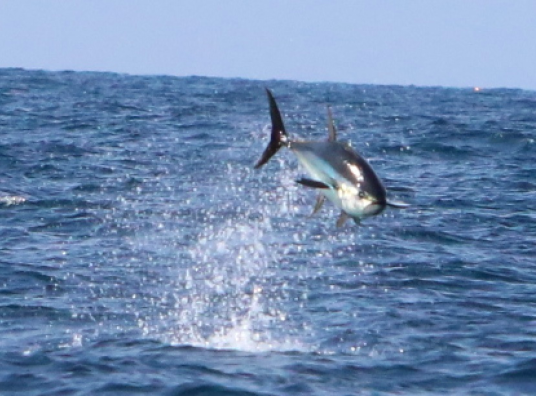
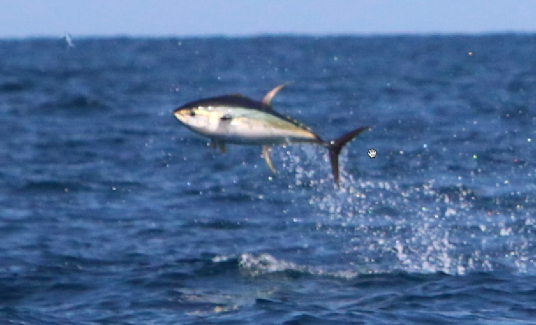
Giant tunas began rocketing out of the water in an orchestrated blitz against panicked baitfish. All lines in, and we began our charge towards the school. The busts were all around us – taunting us in a tantalizing display of aerial fury.
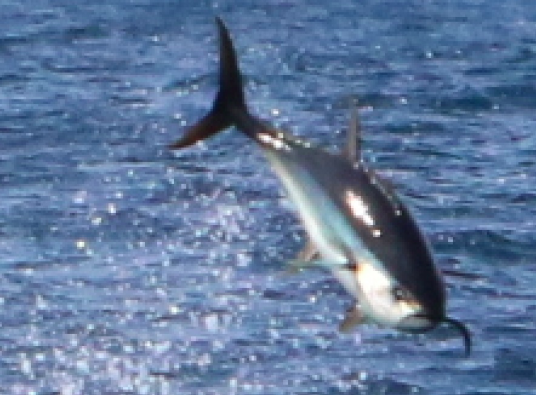
I heaved the plug off the bow and began ripping it across the surface. Nothing. More busts. I heaved the plug again, digging deep into the surf casting roots of my Atlantic beach soul to maximize distance – the plug set down next to an eruption. One more chug – and – boom! Another fleeting moment that will remain forged in my mind as one of the single greatest tuna moments of my life – a hundred plus pound tuna exploded on the plug – knocking it high into the sky. The fish soared through air with it’s mouth open waiting for the plug to fall – but it didn’t. Zero gravity. The force. I don’t know. The yo-zuri just kept soaring through the air as the tuna crashed back into the water. The plug plopped down a few seconds later. I was quivering with frustration, but still overjoyed. A conundrum which is indescribable. I heard the rattle of the plug as the tuna blasted it, but the razor sharp treble hooks did not find a home. The image of that fish exploding into the sky, it’s mouth agape in anticipation of a meal – my plug just out of reach – was painful, but truly and thoroughly sensational. The school leapt off into the distance. We pursued.
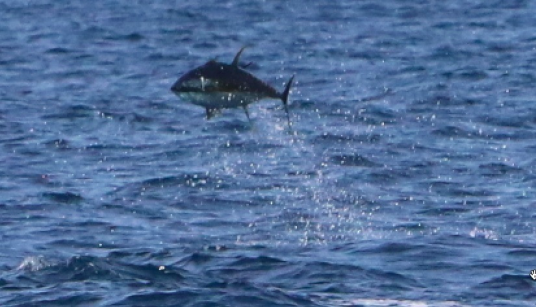
Apparently the real trick, when tunas are jumping in a synchronized assault on bait around an oil rig is to “match the hatch” and drag a rigged ballyhoo while waiting with a popper ready to throw. The school continued to bound in the distance – going away from us, then coming back. A second shot was in store. The tunas, now leaping 5 to 10 feet in the air, pounded their way back towards the boat as Hunter made a slow steady turn towards them – to head them off on their trajectory. The busts grew closer, and closer – the stern rod got nailed and started screaming! Scott hooked up – another bust – another – close enough to cast. I heaved the plug viciously and landed it just 30 yards off the bow. A slow steady draw on the plug gave way to another furious explosion – as if i was tied to a truck – the rod bent over sharp in my hands, then slack, then sharp, then slack, then…it sounded. I’ve fought many, many powerful fish on jigging tackle, but this was an explosion of weight and fury unlike anything I have ever held in my hands. The plug was fixed in that tunas mouth and I have never felt a spinning reel rip that hard in my life. The run would just not end and the braid poured off the Penn Clash with the power of a dozen amberjacks. Incredible. What was likely a four minute run felt like a 1/2 hour by the time the fish quit diving and I was able to make headway. Fighting a 60+lb yellowfin on a jig rod is no joke – it took all of my arms and most of my lower back to pull that fish to submission. It was a fight which just would not end – give and take went on for about 25 minutes while Scott fought another impressive yellowfin at the stern. It was glorious to see that first top water tuna show color at the boat. Rising up from the deep with his brilliant amber sides and razor defined sickles dragging in the current. The thud of the gaff in that fish wasn’t nearly as satisfying as the scream of the drag, but I suppose that’s because I knew the fight was over. Not that I could have handled much more. Despite weeks of physical training in preparation for the trip, my lower back was burning!
What a privilege to be one of the first people in the world to catch a top water yellowfin tuna on the Penn Clash!
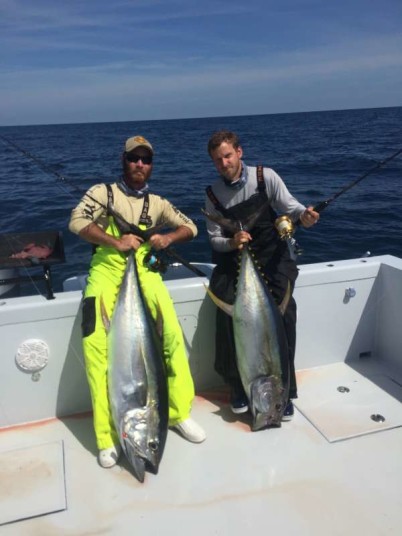
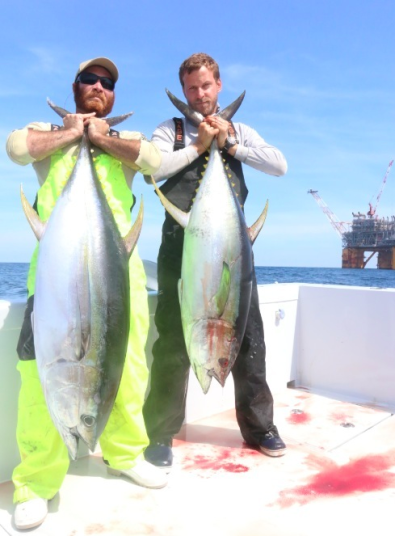
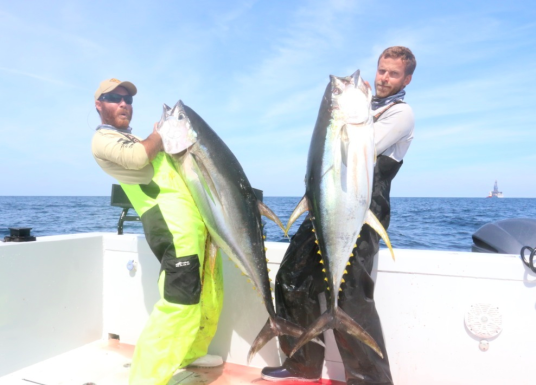
As the excitement drew down aboard Hunter’s boat, the day still had much, much in store for us. The tunas continued to leap and bound their way across the surface – their distance shifting with every minute. The constant eruption of fleeing ballyhoo and flying fish kept our adrenaline flowing as tunas continued to demonstrate their aerial capability. One after another, after another. The surface blitz continued. We went back to chunking, this time a bit farther out from the rig with a drift to intercept the tunas as they wandered to and from the shadow of the URSA. Now fervent in their dedication to follow suit in my top water spoils, Scott and Todd took turns throwing the popper as far as they could. Each cast of that popper kept everyone fixated on the lure as we methodically drew out our lines to keep the chunks going. Boom! Again, another yellow exploded on the popper and began absolutely ripping straight down.
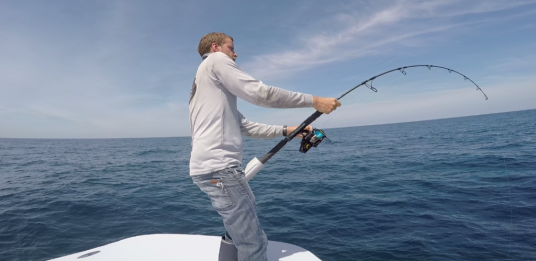
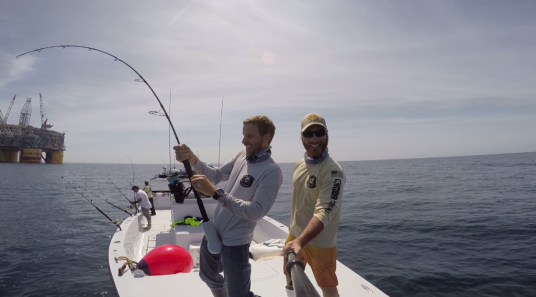 This time Scott was on the rod and began drawing the fish up slowly. Give and take went on for about 20 minutes before the fish reluctantly made its way to the surface. Another incredible top water tuna!
This time Scott was on the rod and began drawing the fish up slowly. Give and take went on for about 20 minutes before the fish reluctantly made its way to the surface. Another incredible top water tuna!
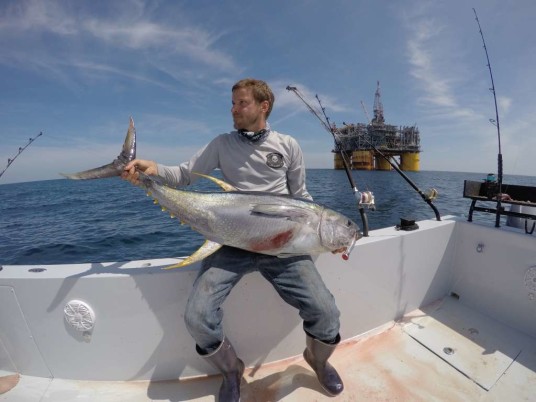
The satisfaction is just unparalleled. The adrenaline soaked experience of witnessing the ferocity of a yellowfin tuna pound a top water popper is surpassed only by that first blistering run. Nothing can touch it. Nothing.
We went on that day to boat three fish on top water plugs, the highlight being a group of 50 to 70lb tunas fighting each other for the popper as Scott ripped it across the surface. In a profound moment of absurdity, when the infallible Captain Hunter glanced up just in time to see a tuna leap out of the water just a few feet off the bow to engulf Scott’s popper – in mid air – he quipped a quick “oh s***!”. That about summed it up. It’s rare you get to hear a seasoned Captain get just as excited as us – this was truly a special occasion, when top water blitzing giant yellowfin tunas decided to cooperate – and our tackle held up.
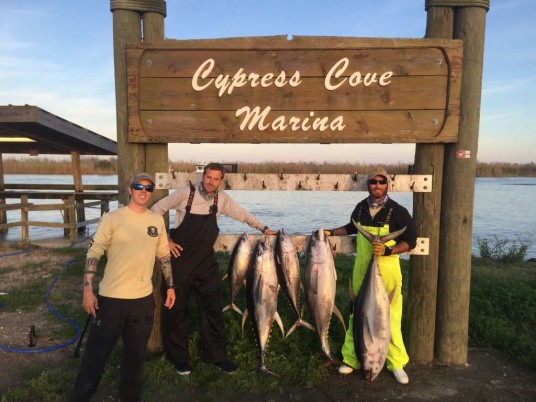
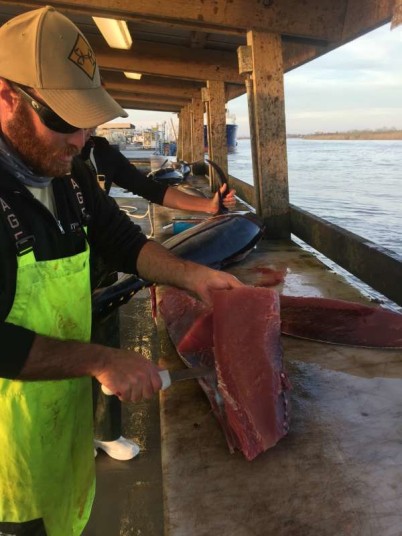
Day 2 – Exploring New Ground and a Deep Water Surprise
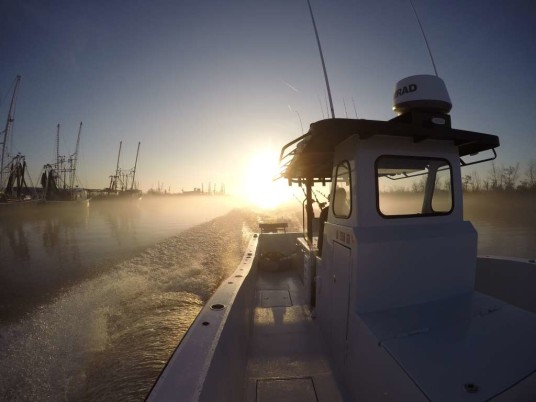
I was thrilled at the opportunity to spend a day exploring new territory with Capt. Hunter on the second day of our expedition. As a full-time charter Captain, it’s rare to find an opportunity when you can break away from the routine and test out new techniques, new numbers, and new equipment. Particularly in Venice, LA, when customers pay big dollars to go out for tuna, it’s a rare opportunity to go fun fishing. Having a day on the water with Hunter to catch up and test out some deep dropping territory was a refreshing change of pace for all of us.
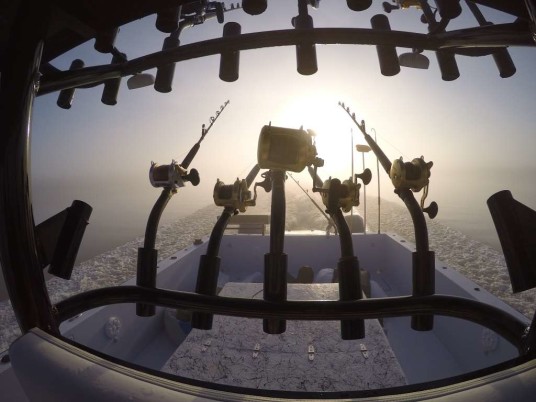
The ride out in the morning put us in extremely heavy fog, which cast an opaque steam drenched glow across the marshes as we pushed through the west pass.
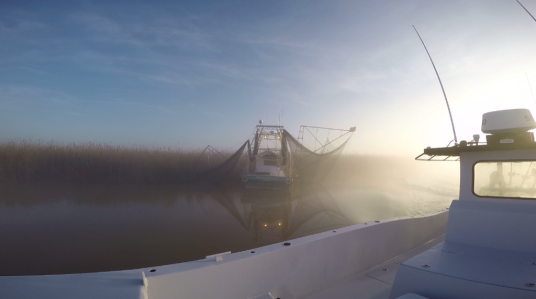
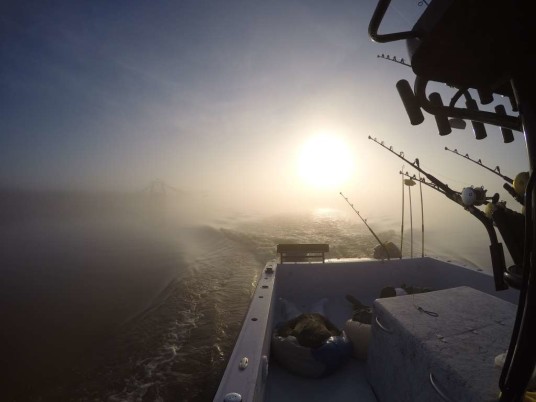
We started our second day working some of the pumping stations for wahoo in the morning, but only managed one specimen.
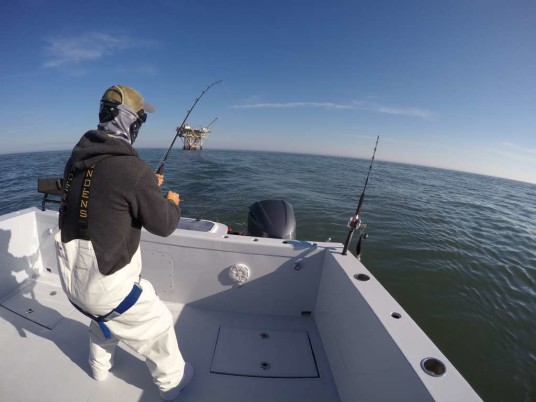
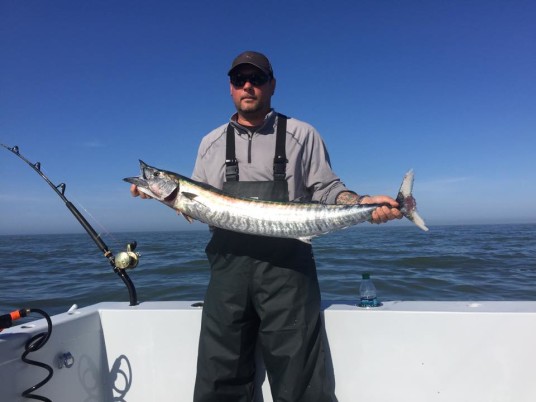 For us, it was an awesome occasion, as any wahoo would be considered a day maker in Miami, Fl! In Venice, LA – not so much. Venice, LA is home to some of the best wahoo fishing in the world – producing fish up to 80lbs on a regular basis. As Hunter explained, wahoo trolling can be very hit or miss, as the fish will often stack up on the rigs and slam baits as they come by. They’re either there and feeding – or they’re not. What’s amazing to me is that wahoo’s here on the south east Florida cost rarely touch giant trolling rapalas, but in The Gulf – they slam the hec out of them. The other major consideration for catching wahoo down here in Miami, FL is water clarity – it’s a rare occasion to find a wahoo in anything other than bluewater. In The Gulf, however, the muddy river water layers on top of blue water- creating a divide in water clarity with muck on top and clear water just below. These conditions are typically ideal for wahoo trolling around the pumping stations, but it just wasn’t in the cards for us. We made a variety of passes from different angles, changed out lures, tried different speeds, but we just couldn’t get a bite. Feeling lucky, Hunter took us to the rig where the state record wahoo had been caught just a few years earlier – the structure was brilliantly commanding in the blue water and certainly looked like prime ground for wahoo.
For us, it was an awesome occasion, as any wahoo would be considered a day maker in Miami, Fl! In Venice, LA – not so much. Venice, LA is home to some of the best wahoo fishing in the world – producing fish up to 80lbs on a regular basis. As Hunter explained, wahoo trolling can be very hit or miss, as the fish will often stack up on the rigs and slam baits as they come by. They’re either there and feeding – or they’re not. What’s amazing to me is that wahoo’s here on the south east Florida cost rarely touch giant trolling rapalas, but in The Gulf – they slam the hec out of them. The other major consideration for catching wahoo down here in Miami, FL is water clarity – it’s a rare occasion to find a wahoo in anything other than bluewater. In The Gulf, however, the muddy river water layers on top of blue water- creating a divide in water clarity with muck on top and clear water just below. These conditions are typically ideal for wahoo trolling around the pumping stations, but it just wasn’t in the cards for us. We made a variety of passes from different angles, changed out lures, tried different speeds, but we just couldn’t get a bite. Feeling lucky, Hunter took us to the rig where the state record wahoo had been caught just a few years earlier – the structure was brilliantly commanding in the blue water and certainly looked like prime ground for wahoo.
We made a few passes and marked absolutely nothing. Not even bait! Without a wahoo to be seen anywhere in the area, we made or way our to the deep dropping grounds to began our search for tile fish, yellow edge grouper, and who knows what else. There are a few boats in Venice, LA which excel at bottom fishing, and Hunter had an itching suspicion he knew where those spots might be. Deep dropping on “the west side” can be very difficult, as there’s such a tremendous volume of area where fish could reside. Our search began on bathyometric charts for territory which resembled some of the better deep dropping ground we cover here in the Atlantic. We found a few areas which looked prime – resembling walls and bottom that’s been productive for us in the Caribbean. We made a few drops using the new Hooker Electric and pulled a few nice bites, but didn’t manage any deep water specimens to the boat. The territory we fished looked legit, but again, it just wasn’t in the cards for us to be deep drop hero’s. Before we wrapped it up for day two of the expedition, we made our way to an area which looked very close to some of the ridges we’ve fished for swordfish throughout the Florida Keys.
Deep, sharp ridges on “the west side” looked ideal for swordfish – so we rigged up with a Stanczyk swordfish wind-on, prepared a strip bait, and began working the bottom. With daylight burning fast, we worked a drop off which looked to be the steepest structure in the area. Slowly bounding down the wall, we saw a slight bend in the rod, but nothing which suggested a true swordfish “whack”. We waited to see if the fish would come back – and sure enough, the rod dipped just slightly again. Suspicious, we came tight and there was a bit of weight! I was thinking small sword or some other random bottom fish, but we hauled up regardless. By the time we hit the leader, there was definitely a consistent wiggle and drag on the line – and wouldn’t you know it – there was a fish! Not a swordfish, but a truly odd deep water specimen – an Escolar!
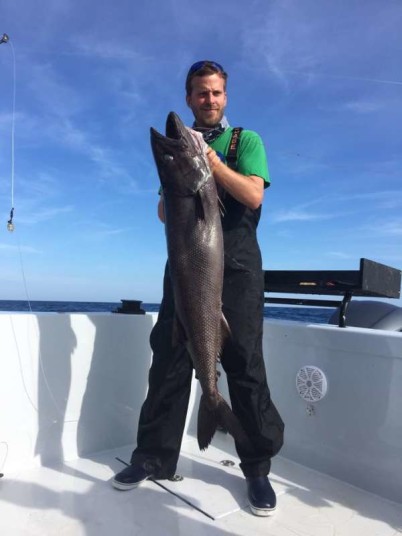
This giant nasty creature had literally engulfed our bait in one bite and was deep hooked. After a few pics, we packed it up and headed in to enjoy a wahoo dinner and a few cautious bites of the oceans “most palatable” deep water fish.
Day 3 – Legacy tuna fishing with Capt. Scott Leger

The story of Paradise Outfitters actually begins in the late 90’s when Scott Avanzino started the operation in the emerging town of Venice, LA. Largely unknown to the global sport fishing community, a few pioneers began experimenting with, and succeeding at catching giant yellowfin tunas, marlin, wahoo, mako sharks, red snappers, groupers, triple tails…well, pretty much everything that swims. Oil rig fishing in the gulf of mexico, almost two decades ago, was something few anglers had ever experienced. Today, the small muddy town of Venice, LA is now legendary – hailed as the port of choice for big game anglers who desire to test their might against the toughest predators the ocean has to offer.
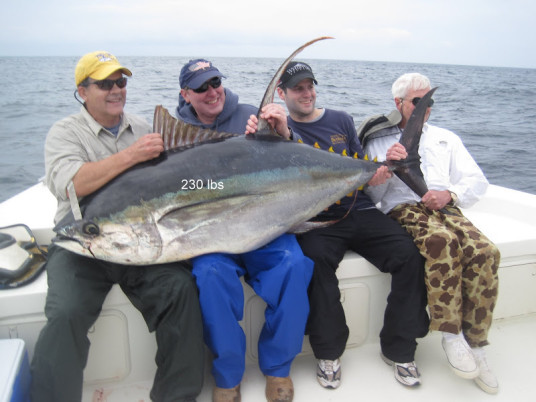
In the early days, Scott Avanzino was the most successful of the pioneer fishermen out of Venice. You may have read about him in the countless magazines and news paper articles that were published at the time. You may also have encountered a photo which featured him or one of his customers with legendary catches. But, as with most impressively bold endeavors, Avanzino was by no means alone in this venture to solidify Paradise Outfitters as the leading crew of Venice, Louisiana sport fishermen. Avanzino was in some ways inadvertently, and in some ways purposefully, training the next generation of elite sport fishermen – two of those truly time tested and incredible crew members – were Scott Leger and Hunter Caballero.
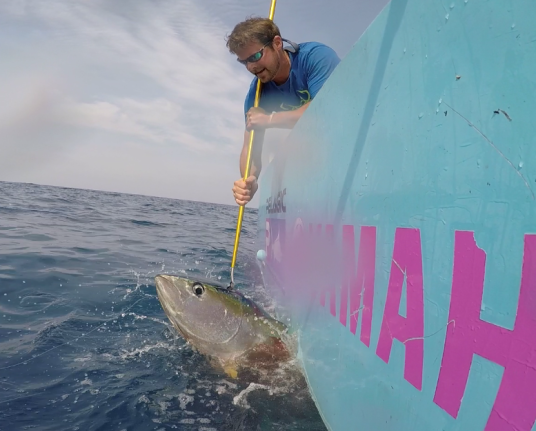
I’d met Scott Leger previously during our expeditions to Venice, but never had the privilege of fishing with him. I regret that! I’ve fished with many anglers, captains, and mates around the world, but few of them are as humble and genuinely amiable as Leger. A Louisiana native and salt-of-the-earth hard working individual, Leger has been on the Paradise Outfitters crew since the beginning. As a mate, he has boated countless trophy tunas, wahoos, makos, and the like. As a Captain, he has guided thousands of customers to catches which are legendary. As an angler, he holds the Gulf of Mexico and State of Louisiana record for Big Eye tuna – a staggering 240lb 3 oz specimen he boated with none other than Hunter Caballero. Leger’s tuna fishing experience is second to none. He is also one of the most loyal, honest, and dedicated sportfishermen you will ever meet.
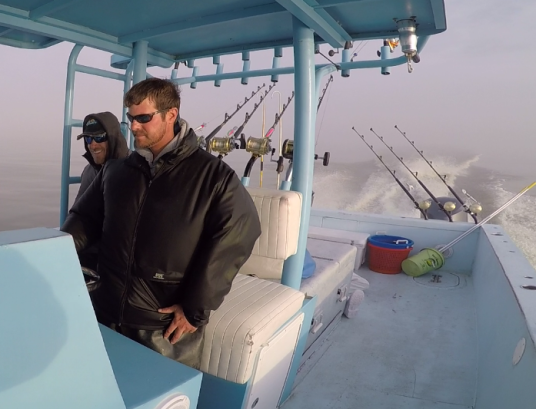
By the third day of our expedition, the rumor was that most of the larger tunas at the rigs were only feeding on live pogies and that chunk baits just weren’t cutting it. Chasing bait on the delta is a difficult endeavor, and as Leger put it, keeping a secret in Venice is impossible. Word spread quick of a small area on the west side that held bait, making it a mad dash first thing in the morning to find the coveted baitfish before anyone else. That third morning we departed the dock into some of the heaviest fog i’ve experienced on the water. Without radar, the trip out of the west pass would have been impossible. We encountered several eerie scenes of shrimp boats nestled in the grass and blind turns which barely held the beam of the original 41′ Fin Cat that Leger operates for Paradise Outfitters. We were rigged for anything, from tuna to wahoo.
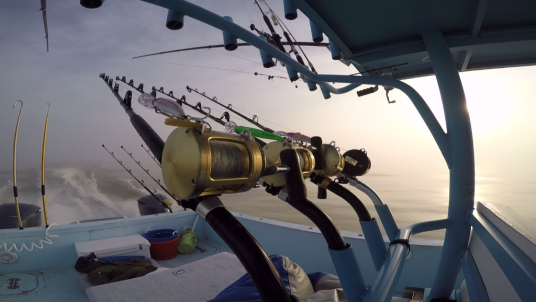
Clearing the west pass put us out into the muddy shores of the gulf in search of pelicans, which we stalked for almost two hours before finding a few that seemed to share where the pogies were hiding.

Taking turns heaving heavy cast nets, we must have thrown a dozen times in order to round up a few dozen pogies. The bait was there, and thick, but just seemed to scatter before our nets made their way to them. With daylight burning, we charged back out to the rig where the tunas had been leaping out of the water the day before. The run from the Mouth of the Mississippi to the floating rigs is not a short one, which afforded me the perfect opportunity to learn more about the legacy of sport fishing in Venice, LA as well as Leger’s personal experience with how the industry changed over time. What I found most intriguing during our conversation was how he described the change in tactics. The techniques they used to catch tunas a decade ago would hardly find a place in today’s environment. Did the fish get smarter? Are they responding to pressure? Have the feeding habits changed? It sounds that way. Leger painted a picture of an untamed wilderness, specifically recalling how fishing the midnight lump once relied on the use of a heavy mono leader, giant circle hook, and dead pogie spiraling in the current. While chunking is still effective today, fluorocarbon and small 6/0 3X strong circle hooks are the mainstay of the fleet. A spiraling dead pogie with a huge hook engorged in its head is laughable by modern standards, but worked flawlessly back then. Kite’s, for example, rarely find their way to the sky as the need to float rubber flying fish out on a line just isn’t there. The changes in tactics that Leger described echoed some of the changes i’ve experienced here in Miami, FL. For one, the bait has become increasingly more difficult to acquire. Secondly, most of the wrecks and reefs we fish today are covered up in boats, whereas a decade ago, I hardly recall seeing another vessel in sight of me when fishing down south. I suppose that’s how it goes and change is the only constant we can depend on in this rebounded and moderately shell shocked economy, but I found it striking that even in one of the most up and coming sport fishing destinations in the world – a veteran noticed their way of life changing around him. Leger asserts that the fishing in Venice, LA is actually better than he ever remembers – citing the shear volume of giant tunas he’s caught, and seen caught, in the last two years. I’m inclined to agree with him, but then again, i’m just a guest in their daily routine of catching oversized tunas that fight like freight trains.

We concluded our 45 mile run with an arrival to one of the most odd ships i’ve personally encountered. While drilling ships may be common in the Gulf of Mexico, i’d never seen one up close and personal. The “Noble Bully”, as it read across it’s stearn, is massive and has been in place for quite some time. Drilling ships provide the same structure and protection for baitfish as the floating rigs, which makes them prime targets for tuna fishermen. Arriving to the ship as helicopters circled about, taking tandem turns landing and leaving, we deployed our spread – two live pogies hooked through the bottom lip – essentially freelined. We marked fish deep around the ship, but they just wouldn’t come up to bite the slimy wiggling pogies, free drifting in 5000 feet of water. We hauled up and made the run to another drill ship which was just to the North of the URSA, where we had witnessed the giant tuna jumping bonanza on the first day of our expedition. We lined up at the front of the ship and deployed our first round of chunks to no avail. We circled around again and made a second drift. Sometimes, chunking can get monotonous. You want that bite so bad, and every pull could be the one, but your mind begins to play tricks on you. You wait, and each gentle drag of the current sends your heart racing. It’s a game of managing anxiety while staying perfectly prepared for that single instance when you must swiftly thrust the drag lever to strike, or risk losing what could be a trophy tuna. There’s just no way to know what might grab your chunk.
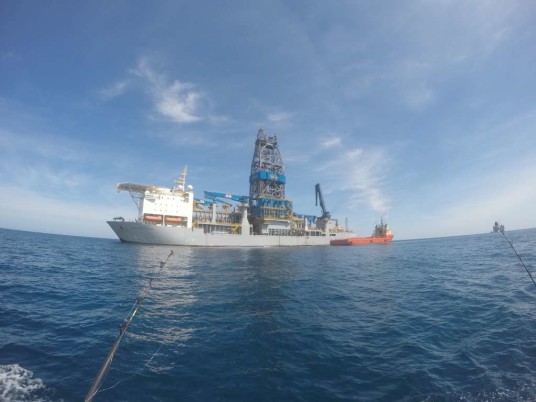
By our fourth bite-less drift, i’ll admit I felt worried. Not that we were doing anything wrong, but i’m used to fish shutting down on us. It happens in Miami, FL all the time. Whether it’s the current, the bait, the moon, the water temperature, or any other myriad of factors – fish can just “turn off” and there’s nothing you can do about it. The rumors of the bite shutting down were fluttering in my mind, but in an instant, it all changed – the line ripped out of my hands and instinctually (hey, I was impressed it actually happened like that), my right hand nudged the drag lever to strike and the fish began ripping. Hooked up! I moved the rod to the belt and was pleased to find an angry tuna jockeying against me. Just a few minutes into the fight – Todd comes tight too! Adjacent to me on the gunnel, his fish is acting a bit funny. He wasn’t sure whether it was a small fish, or if he was tangled in my line. We frantically began to “unwrap” the line crossing before it cost us what felt like a decent fish. As I worked the fish up from the depths, without much relief from heavy pressure, it became apparent that this fish had made the terrible mistake of ingesting two baits with hooks! This tuna was double hooked between myself and Todd – after a few more minutes, the fish was in the boat – with two circle hooks vested in the corner of its mouth. A fitting end to a gluttonous tuna!
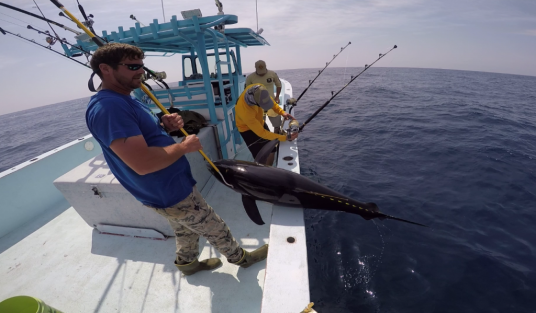
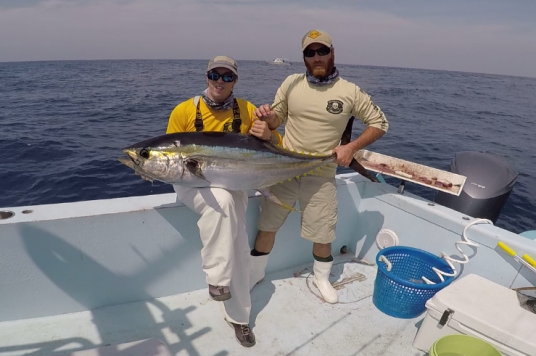
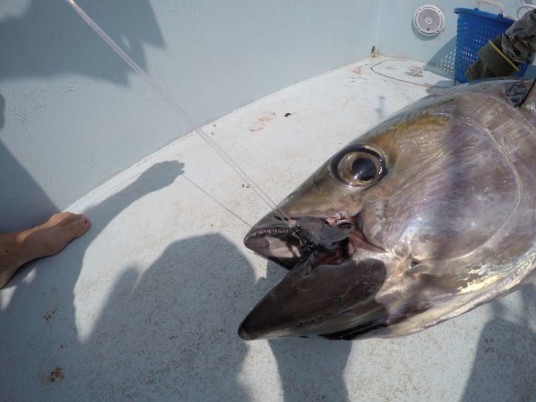
After working hard to get the bite at the drilling ship, and with time winding down on the third day of our expedition, we made the run South to the URSA – leaving the drilling ship behind for other Captains to work. We arrived and began immediately marking fish – chunks out but no bites. One of the amazing skill sets of the Paradise Outfitters crew is to understand where to position the boat in order to draw a strike. After our first drift not producing any fish, Leger moved us closer to the rig on the north side, drifting with the current, slowly to the south. As if on queue during the next drift – my rod loads up and the drag on the 50W tiagra starts screaming. It’s a BIG fish. Ripping drag on the 50 for 30 seconds – I call for the harness and strap in. The fight is on and the fish is HEAVY.
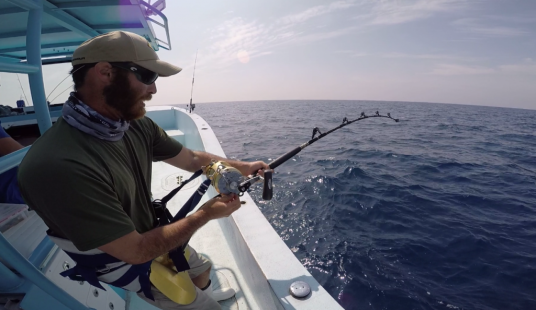
When you’re tired, as you should be after several days of tuna fishing in Venice, LA, big fish feel even bigger – but there was no doubt in my mind. This was a serious tuna. Each gain led to another pull. I would bring in 10 yards, the fish would take 15.

This tug of war went on for about 25 minutes before the fish finally showed some color – big sickles, a mean head, and a furious head beat which signified it was getting tired. Watching the fish go broad side to me, just 100 feet down, burned the image of that tuna into my mind. I began to recall the moment I first saw the 145lbr I caught with Hunter the previous Fall – a furious tuna pulling with all of its primordial strength to return home – to the depths. My legs were straining from sitting down on the fish in the harness, but my arms and back were fine. Being careful not to apply too much drag, I lifted the fish and was able to put prime pressure just as he went weak. Up pops the beast and Leger is there with a swift gaff shot to the head. Done. Up and THUD on the deck he goes. A prime ~ 70lb yellowfin.
We were ecstatic – not because we had the fish in the boat, but because we knew there were more coming.
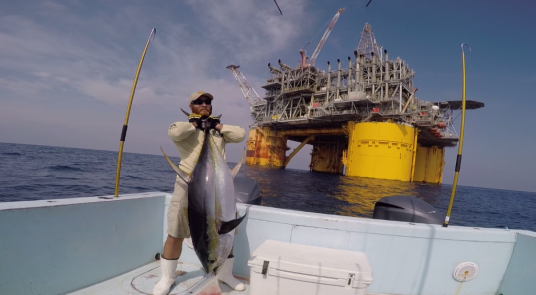
We iced down the fish and circled right back around to the corner. Chunks out – this time – Scott gets nailed and the fight is on! Another bruiser fish ripping line into the deep. Leger had them dialed, and we knew it was about to get epic.
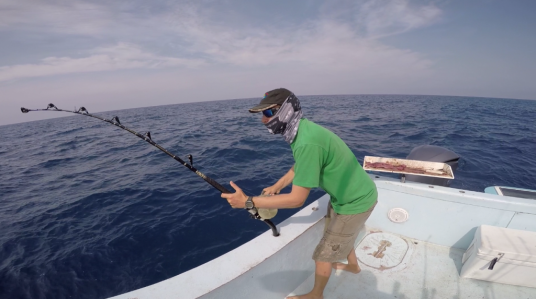
Scott Virgin has caught many incredible fish through the years and i’ve been fortunate to be with him for many of those occasions. Never in my life had I seen him as ecstatic as he was on this occasion. The tuna would rip line, and Scott would smile like he just won the lottery. The tuna would dog him, and Scott would laugh. It’s a humbling feeling to watch an angler who is so lost in the moment that everything else fades away and nothing else matters. That’s what big game fishing is all about, particularly tuna fishing on the Oil rigs. Leger gets it. Caballero gets it. It’s a feeling of freedom. A fleeting feeling that your heart and mind remember, but your body forgets, until you feel the weight of the fish and hear the scream of the drag. Unstoppable.
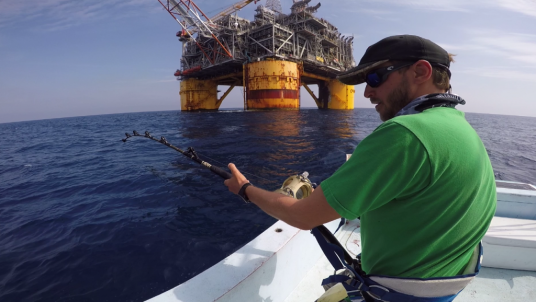
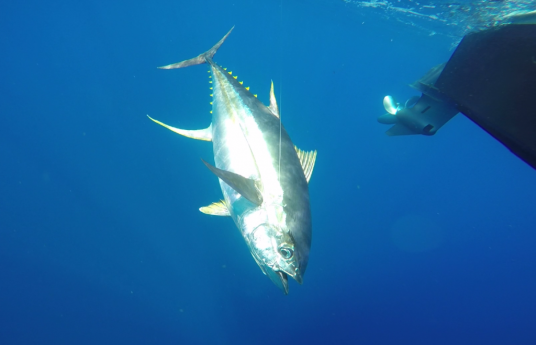
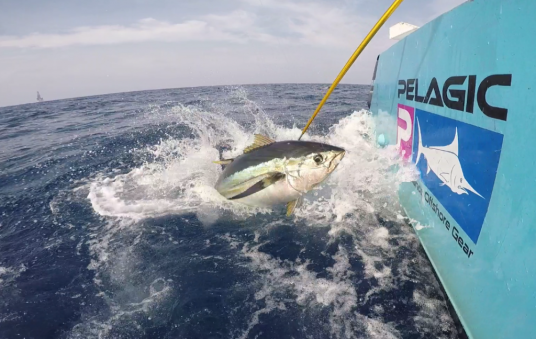
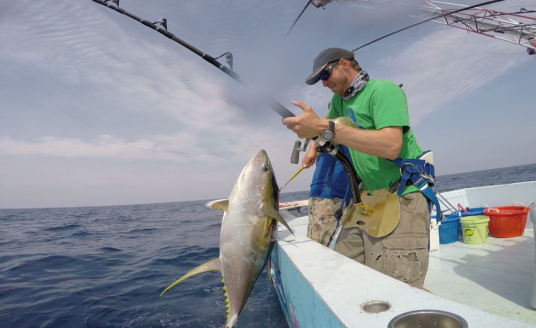
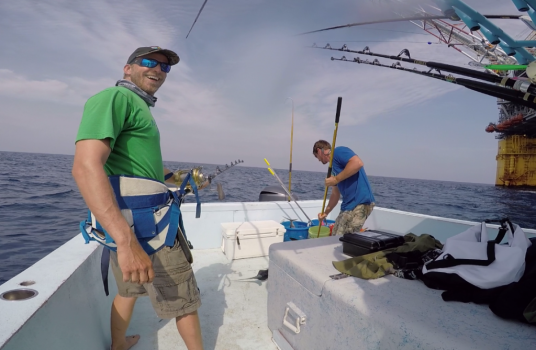
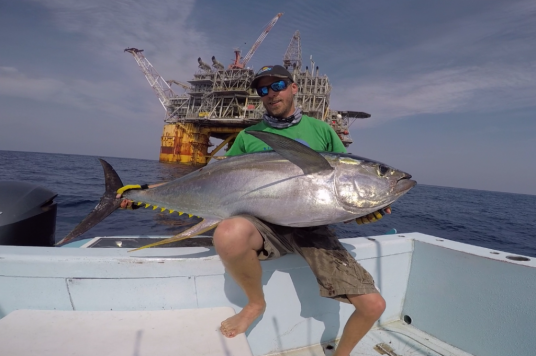
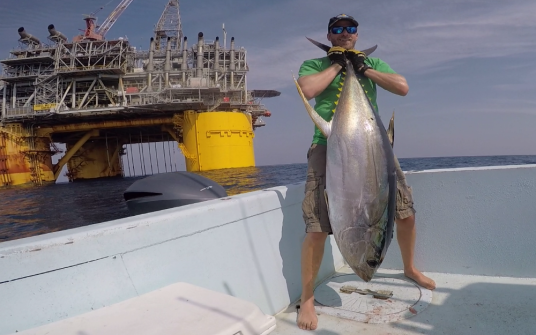
Scott’s fish was a beauty – a magnificent specimen which captured the conclusion of our expedition in full glory. Giant yellowfin tuna fishing in Venice, LA is not for the mentally or physically unprepared. It is a privilege. An experience which slowly evolves into an addiction. The crew of Paradise Outfitters is addicted – they do this not because they have to, but because they want to. Because every morning, they still love it. They still give everything they have to give to share the remarkable experience of big game fishing with those who seek the ultimate sport fishing thrill. There are few places in the world you can travel where the contrast between humanity and nature is as profound as the super structures towering above the endless ocean – harboring both predators, and prey.
How do I even tell this story? In many respects, I can’t. No matter what i’ve written here – my memory is so overwhelmed with the details of the expedition that to capture all of it is just impossible. The experience of fishing with the Paradise Outfitters crew is indescribably amazing. If you sit back and imagine the perfect fishing charter operation – it would be difficult to imagine anything other than this. But it’s not just about the business, or the fishing. It’s not just about the enchanting moments of flying through the fog in the baddest boats on the planet, the chill of the marsh air against your face as you charge towards the most unbelievable fishing in the gulf of mexico. It’s about something greater. That feeling of holding a rod while a monster yellowfin grabs your popper off the surface just yards from the boat. That feeling of watching your friends catch their fish of a lifetime. That feeling of knowing that it’s not over – that even if this expedition comes to an end – that’ we’ll get to come back. This journey into the heart of the Gulf of Mexico is just one episode – one taste of the life Paradise Outfitters lives every day. We are privileged to have joined them, again – Hunter, Scott, and the rest of the crew – to experience their way of life, their legacy.
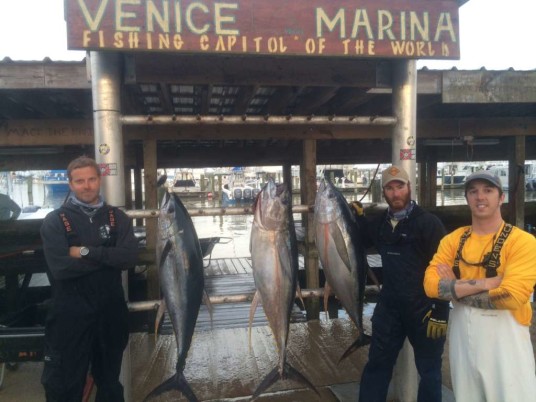
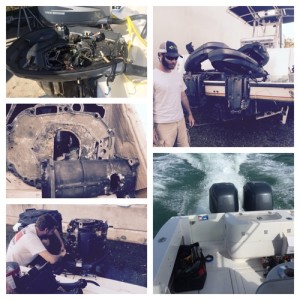 After several months of spending our evenings and weekends helping to rebuild outboard engines, it felt pretty great to get back on the water, and enjoy some kitefishing. Big thanks to Capt. Scott Virgin for helping team Marauder keep the dream alive. We wake up early and stay late to log hours catching big fish.
After several months of spending our evenings and weekends helping to rebuild outboard engines, it felt pretty great to get back on the water, and enjoy some kitefishing. Big thanks to Capt. Scott Virgin for helping team Marauder keep the dream alive. We wake up early and stay late to log hours catching big fish.
The boat was back in action just after testing in the final weeks of December, and the first part of January. We dusted off the gear, and got back to business, catching some sailfish, mahi, kingfish, and snapper in our first few trips back on the water.
The first few weeks of January were a bit slow with lots of sharks, some kingfish, and mahi, but only a few missed shots at lazy biting sailfish. On a private charter out of haulover inlet, we did get a sail for a friendly vacationing snowbird, and a small blackfin.
The passed 2 weekends in January started to pickup, and we ran some trips, and started putting up some sailfish releases. The surface bite has been picking up as the temperatures start to finally drop. With a day on our hands, and a lot of live bait, we have managed to log the hours it takes to get a couple sails per day on the kites.
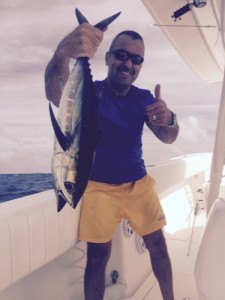 Always feels nice to get a little sushi off the kites, and see a billfish dance across the surface after spending an afternoon waiting for the show.
Always feels nice to get a little sushi off the kites, and see a billfish dance across the surface after spending an afternoon waiting for the show.
The last week of January, the bite has started to pick up. Live bait fishing has been better, with pilchards becoming more accessible, and pelagics being reported in much greater numbers.
I fished aboard the Top Gun with Capt. Nel, and Capt. Danny, and caught a few nice big sailfish off the kites for a 40th birthday party. The crew stuck out some tough seas to see the sailfish sprint across the surface with a speed that reminds you why it’s called sportfishing. Definitely a great day to spend a surprise birthday party. It never gets old seeing the thrill of seeing someone fight a trophy fish. Despite fighting some tough seas and a sea sick angler, we got a few nice video shots of the second fish. I had to remind him that I do this often – I’m a professional.
Jumping Atlantic Sailfish aboard the Top Gun Miami
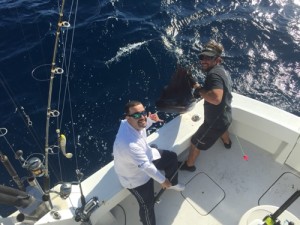 Capt. Danny fishes offshore with the Top Gun, and runs some inshore fishing charters in Miami as well. Danny and I decided to get together with Capt. Charlie to do some tarpon fishing inshore near downtown Miami, and caught a half dozen mangrove snappers and went 3 for 3 on tarpon in just a few hours after dark. Danny is available for nearshore trips at Salty Adrenaline charters on his pathfinder.
Capt. Danny fishes offshore with the Top Gun, and runs some inshore fishing charters in Miami as well. Danny and I decided to get together with Capt. Charlie to do some tarpon fishing inshore near downtown Miami, and caught a half dozen mangrove snappers and went 3 for 3 on tarpon in just a few hours after dark. Danny is available for nearshore trips at Salty Adrenaline charters on his pathfinder.
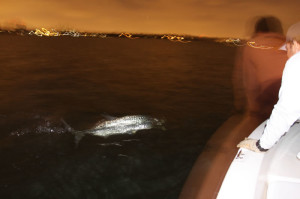
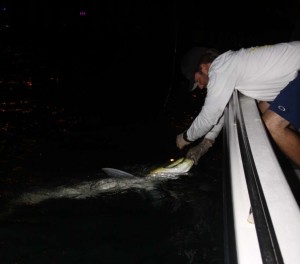 This passed week or so, there has been some fantastic sailfish reports. Lots of nice schools came through with the cold fronts, and cooler weather. The rough and the cold seemed to yield strong results for those who donned raingear and braved the 15-20 knot winds.
This passed week or so, there has been some fantastic sailfish reports. Lots of nice schools came through with the cold fronts, and cooler weather. The rough and the cold seemed to yield strong results for those who donned raingear and braved the 15-20 knot winds.
I decided to take advantage of some very fishy type conditions (ne winds 10-20knots, and ne seas) and pack a few friends I promised a day of fishing onto the Marauder. I was privileged to help them both catch their first sailfish, and I can say that the experience never ceases to be exciting.
We spent a slow afternoon off government cut with very little current after catching some live pilchards and herring on sabiki. We weren’t really moving, so our general kite routine didn’t fit the bill. We hit a few wrecks with little luck, and only a small shark was caught on the first two spreads between 100′ – 300′ of water.
We decided to fuel up, and head down to the south. We set a drift just passed fowey lighthouse, and unfortunately there was still very little drift to our drifting. We realized we weren’t yet moving – so we decided to move.
Pushing further to the south, I figured maybe we could pick up a few snapper for dinner, bottom fishing while we had the kites out. The wind was perfect, but the water color was still murky and green. We hit two more shipwrecks to no avail, and proceeded to the final southern destination for the day.
The first drift provided a few bottom bites and cutoffs, and the second gave us the first real action for the day. The line shot off the reel, and grabbed the rod as our new angler had kept the kite baits in excellent position. The sail shot across the water and took off to sea. We cleared all the gear and chased him down. It always feels good to grab that leader, and even better when you get to grab the bill.
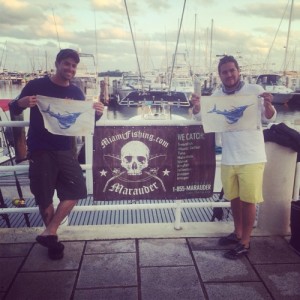
It was getting late, but I couldn’t stand to have one of our anglers catch a fish, and the other have to just watch, so we did two final drifts, emptying our livewells of live bait in a nice little pilchard chum slick. We saw the second fish take off with a bait and screaming drag, providing that rush of adrenaline you only get catching that fish that can run a hundred yards faster than most humans.
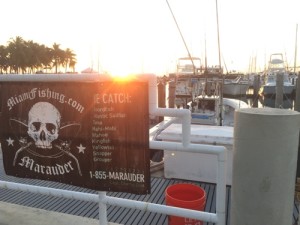 It was a long day that started early, and ended late, but made for a great trip, and some happy customers. It’s great to be back on the water running trips, and catching fish. Our late winter, and spring weekends are definitely filling up. If you have a chance to get out on the water and join us, please feel free to give us a call.
It was a long day that started early, and ended late, but made for a great trip, and some happy customers. It’s great to be back on the water running trips, and catching fish. Our late winter, and spring weekends are definitely filling up. If you have a chance to get out on the water and join us, please feel free to give us a call.
No one wants to admit it, but the truth is that September and October are transition months for fishing down here in Miami, FL. Some days, it feels like there’s just no fish in the ocean.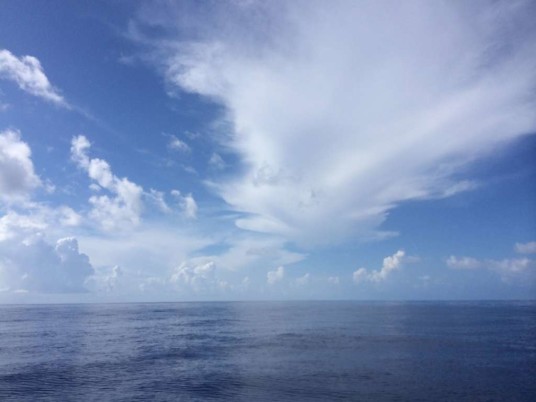 While the fishing in Miami, FL is great year round compared to almost everywhere else in the U.S, September and October are typically the slowest months for offshore fishing due to a myriad of environmental factors beyond our control. In order to keep the rods bent this fall while you wait in anticipation of the upcoming sailfish season, try these four fall fishing tips!
While the fishing in Miami, FL is great year round compared to almost everywhere else in the U.S, September and October are typically the slowest months for offshore fishing due to a myriad of environmental factors beyond our control. In order to keep the rods bent this fall while you wait in anticipation of the upcoming sailfish season, try these four fall fishing tips!
Push Farther Offshore
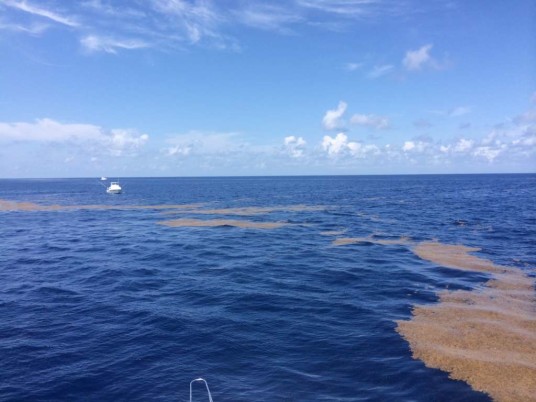 While the fall is not considered the hottest time of the year for targeting mahi-mahi, there are still good numbers of schoolies offshore. These keeper “schoolie” sized mahi’s make for excellent table fare and if you put in the time to locate them, you can still catch upwards of 20 in a day. The trick is to make your way farther offshore than you would during the spring and early summer months. As the weather heats up, these fish tend to move out deeper and search for bait under grass lines. It’s also common this time of year to see large flocks of frigates and birds chasing schools of jacks; typically mahi-mahi will follow the schools in tandem with skipjack and blackfins.
While the fall is not considered the hottest time of the year for targeting mahi-mahi, there are still good numbers of schoolies offshore. These keeper “schoolie” sized mahi’s make for excellent table fare and if you put in the time to locate them, you can still catch upwards of 20 in a day. The trick is to make your way farther offshore than you would during the spring and early summer months. As the weather heats up, these fish tend to move out deeper and search for bait under grass lines. It’s also common this time of year to see large flocks of frigates and birds chasing schools of jacks; typically mahi-mahi will follow the schools in tandem with skipjack and blackfins.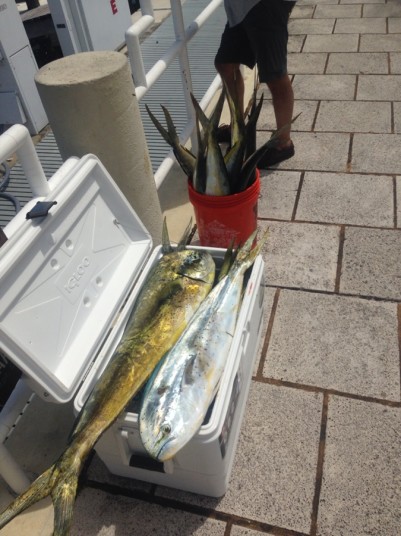 The best bet is to cruise offshore slowly – not trolling – looking for birds or debris. We typically ride out to 1200 ft and stop along the way if we find birds or grass – then begin trolling to locate fish. Some of the most common places to find fish in the fall months includes the “double zeros” and anywhere between the 55 and 57 line. Those numbers refer to coordinates on your GPS – put in a bit of research and you’ll get the hang of the locations most charter boats start their hunt for schoolies. It’s rare that you would need to push out deeper than 2000ft while looking for mahi in the fall months – concentrate your efforts between 1000ft and 1600ft and you’ll likely find a few fish. It’s crucial to find grass, birds, or floatsam – trolling aimlessly in deep water may produce a bite occasionally, but you’ll enjoy catching more fish if you have a gameplan.
The best bet is to cruise offshore slowly – not trolling – looking for birds or debris. We typically ride out to 1200 ft and stop along the way if we find birds or grass – then begin trolling to locate fish. Some of the most common places to find fish in the fall months includes the “double zeros” and anywhere between the 55 and 57 line. Those numbers refer to coordinates on your GPS – put in a bit of research and you’ll get the hang of the locations most charter boats start their hunt for schoolies. It’s rare that you would need to push out deeper than 2000ft while looking for mahi in the fall months – concentrate your efforts between 1000ft and 1600ft and you’ll likely find a few fish. It’s crucial to find grass, birds, or floatsam – trolling aimlessly in deep water may produce a bite occasionally, but you’ll enjoy catching more fish if you have a gameplan.
Don’t neglect the deep drop
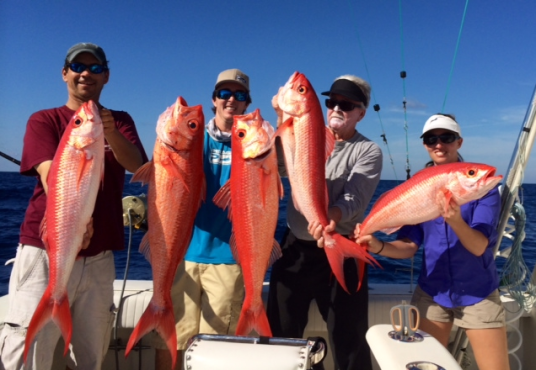
This can be a day saver more often than not. Vermilion snapper, queen snapper, tilefish, and various deepwater species can be found off the coast of Miami, FL in depths from 300ft to 700 ft. The key is to find the right bottom where your target deep water species resides. Vermillion snappers typically live in depths of 250 to 500 ft, but seldom deeper. Tilefish typically live in depths of 500 to 700 ft, but usually on soft bottom. Learn as much as you can about each species before you target them – there’s plenty of general knowledge out there which will give you a head start in working the appropriate areas for each fish. While deep dropping may not be the most glorious kind of fishing we get to enjoy in Miami, FL – when the edge is not producing and the dolphin start to disappear offshore, deep water fish can provide steady action.
Mind the mid-waters
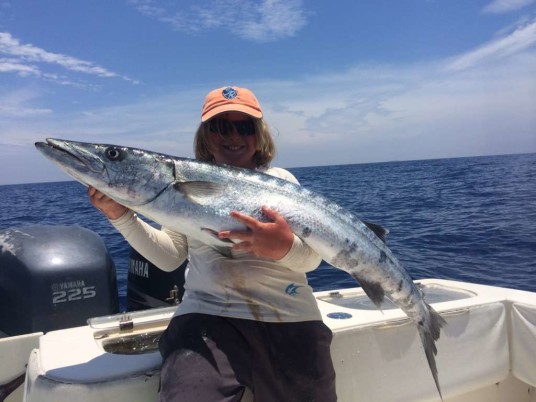 Flat lining and mid-water live baiting can produce a steady bite if current around the edge is consistent. A mix of bonitas, barracudas, and kingfish tend to dominate the water column between 100′ and 150′ during September and October – while not glorious fishing by any means, they can provide steady action. The trick is to fish the entire water column without tangling your live baits – this is typically best accomplished by drifting broad side while using a series of progressive weights (1.5oz, 2oz, 3oz) to suspend baits at various depths. We typically put out out a bottom rod, followed by baits at ~ 70ft, 50ft, and 30ft with a flat line on the surface. Once we start getting bites at a specific depth – we’ll adjust our baits to that range and work it thoroughly. This technique works particularly well when fishing in the vicinity of the country wrecks – anywhere from Key Biscayne north to the Boil.
Flat lining and mid-water live baiting can produce a steady bite if current around the edge is consistent. A mix of bonitas, barracudas, and kingfish tend to dominate the water column between 100′ and 150′ during September and October – while not glorious fishing by any means, they can provide steady action. The trick is to fish the entire water column without tangling your live baits – this is typically best accomplished by drifting broad side while using a series of progressive weights (1.5oz, 2oz, 3oz) to suspend baits at various depths. We typically put out out a bottom rod, followed by baits at ~ 70ft, 50ft, and 30ft with a flat line on the surface. Once we start getting bites at a specific depth – we’ll adjust our baits to that range and work it thoroughly. This technique works particularly well when fishing in the vicinity of the country wrecks – anywhere from Key Biscayne north to the Boil.
Raid the Reefs
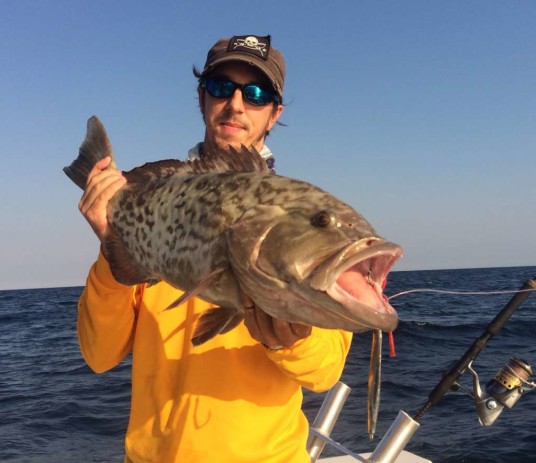 We tend to get caught up in offshore fishing because you never know what you might catch when fishing deep water. In the fall months, when the offshore bite really slows down, the reefs from Fowey Rocks south to Key Largo tend to be very productive. Fishing deep water reefs in the range of 80′ to 110′ can produce mutton snappers, yellowtails, gag or black groupers, and the the occasional amberjack. The key is to find good current and bottom structure with substantial relief. The more rocky and jagged the bottom, the better. Spend the time slow trolling over reef lines until you locate structure that is very pronounced – then anchor up into the current and start fishing. Move around regularly to try different areas unless you’ve found some terrain which really seems to hold alot of life. Keep a chum slick going at the surface while working the bottom with knocker rigs and finder rigs. Use a mix of live bait, cut bait, and even jigs to see what’s in the area. Between September and early November, the bite tends to get pretty good off the ragged keys all the way down to Ceasar’s creek – put in the time to find solid reef structure and you’ll reap the rewards.
We tend to get caught up in offshore fishing because you never know what you might catch when fishing deep water. In the fall months, when the offshore bite really slows down, the reefs from Fowey Rocks south to Key Largo tend to be very productive. Fishing deep water reefs in the range of 80′ to 110′ can produce mutton snappers, yellowtails, gag or black groupers, and the the occasional amberjack. The key is to find good current and bottom structure with substantial relief. The more rocky and jagged the bottom, the better. Spend the time slow trolling over reef lines until you locate structure that is very pronounced – then anchor up into the current and start fishing. Move around regularly to try different areas unless you’ve found some terrain which really seems to hold alot of life. Keep a chum slick going at the surface while working the bottom with knocker rigs and finder rigs. Use a mix of live bait, cut bait, and even jigs to see what’s in the area. Between September and early November, the bite tends to get pretty good off the ragged keys all the way down to Ceasar’s creek – put in the time to find solid reef structure and you’ll reap the rewards.
 The American Sport Fishing Association puts on an annual show for retail buyers everywhere to see new products, and make discount purchases for the year. I attended iCast last year, and enjoyed meeting vendors, and seeing new products. As a fisherman, it’s a bit like Christmas window shopping – looking at all kinds of amazing new fishing gear, and not actually being able to fish with it!
The American Sport Fishing Association puts on an annual show for retail buyers everywhere to see new products, and make discount purchases for the year. I attended iCast last year, and enjoyed meeting vendors, and seeing new products. As a fisherman, it’s a bit like Christmas window shopping – looking at all kinds of amazing new fishing gear, and not actually being able to fish with it!
The ASA is responsible for some of the most comprehensive fishing studies in the country on sport fishing, and hosts this annual event which is a must attend for manufacturers, retailers, and media in the fishing industry.
Being lucky enough to have a few friends in Orlando, I decided to take a road trip, and enjoy a quick stop to see the coolest gear being released this year. Unfortunately, I chose the wrong day, and wasn’t able to see the new product showcase this year, but I did visit a lot of friendly folks that I had met in Las Vegas the previous year, and got to talk fishing with some talented fisherman like Capt. Billy Clyde.
First on that list was the good folks at Spool-Tek Lures. While there are a lot of cool lures available at the show – these lures are especially useful for snook and tarpon fishing, but will serve as a great go to artificial bait for many species. These guys took some serious time and dedication to innovate something to catch the fish they love. A spool tek has a retractable cable inside to reduce the amount of break offs and thrown hooks on big fish near structure. They are also planning to release extra length cable leaders for longer deployment on larger fish.
Checkout the video, and a couple of the photos from the show.
These are great looking lures, and really looking forward to giving them a toss soon (I just ordered a couple online – retail is ~$19).
Next up was the guys from Tacklewebs – Capt. Mike Ortego does a Florida Fishing radio show, and was extremely friendly last year, and offered me a free one. We used it aboard the Marauder, and loved it. Great way to store anything. They’ve also added “CoolerWebs” which is a nicet way to store sandwiches inside a cooler so they don’t end up soggy from the ice! Really cool, useful products from some friendly guys.
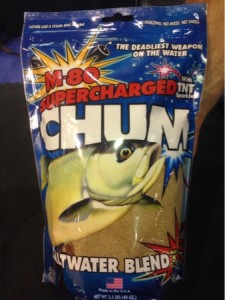 Next up on the list of great products from cool people is M-80 chum. David May and I spoke at the 2013 iCast, and he was among the friendliest folks I met. He is excited about their product, and it’s use. He gave me a bag last year, and I can tell you it worked excellent in raising fish to the boat in a variety of circumstances.
Next up on the list of great products from cool people is M-80 chum. David May and I spoke at the 2013 iCast, and he was among the friendliest folks I met. He is excited about their product, and it’s use. He gave me a bag last year, and I can tell you it worked excellent in raising fish to the boat in a variety of circumstances.
M-80 dry chum is flexible for different fishing situation for attracting, catching, and even just feeding live bait (lots of folks keep those precious baits penned up here in Miami!). Thanks again David for the product sample last year, and for being so friendly and enthusiastic about your product.
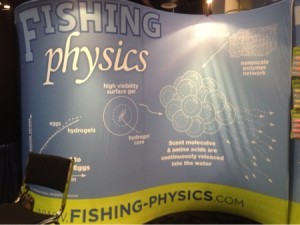 Fishing Physics gets an honorable mention for having a very friendly booth staff, and some free samples. They explained their product quickly and simply (hydrogel lures with biodegradable fish scents), and were very pleasant.
Fishing Physics gets an honorable mention for having a very friendly booth staff, and some free samples. They explained their product quickly and simply (hydrogel lures with biodegradable fish scents), and were very pleasant.
I didn’t get the name of the staff member, but it was nice to be greeted by someone when I walked by the booth with an interested look. Nice work on your booth, and I’l be sure to try the sample.
Finally, I’d like to give a shout out to all the products I’d love to use, but currently don’t have in the Marauder fishing budget. We’d be happy to take a look at your products anytime if you’re trying to market your product to offshore saltwater fisherman like our clientele.
Overall, iCast was a great experience. It seemed the majority of the folks fall into a few categories. 1. large retail buyers 2. manufacturers 3. media and other. While I have written online for many years, I don’t know that I really qualified in any of these areas currently, but it was a very enlightening experience as to how business gets done within the fishing industry. Thanks again to the friendly folks with the great products, and to the ASA for putting on such a great event. Looking forward to the 2015 event!

It’s that time of year when the summer doldrums begin and the surface bite shuts down. What better time to get serious about bottom fishing and start putting more big groupers in the boat! Grouper fishing in Miami is one of those satisfying endeavors which takes a bit of time to perfect, but once you’ve got these stubborn (and delicious) reef critters in check, you’ll enjoy constant success and plenty of fresh fish dinners. We’ve experimented with a variety of grouper fishing techniques all over the world but always find ourselves falling back to these five surefire grouper fishing techniques which are tried and true. If you’re looking to step up your grouper fishing game, then this article is for you.
Find Habitat That Holds Fish
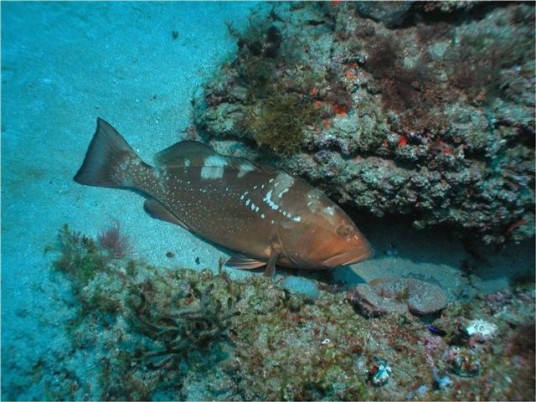
It’s no mystery that groupers love rocky structure in deep water. Grouper are part of the Mycteroperca family, which means these bottom dwelling predators enjoy anatomical features which are perfectly suited for strength and endurance in a fight to the finish. Groupers make their home under coral ledges, within rock piles, and particularly wreckage fro sunken ships and debris. They are ambush predators, which means they remain mostly concealed until they are ready to engulf their prey. Finding structure where grouper’s hide is somewhat straightforward, but it does require a specialized eye to identify areas that are fishable. Drifting for groupers can be effective, but your best bet is to find an area with very rocky bottom, or anchor just off a ledge, then work the area meticulously. Groupers abound in jagged structure which holds baitfish – so if you’re marking fish on the bottom (i.e. lots of bait), it’s likely there will be some larger predators in the area. Groupers rarely pass up pinfish, blue runners, goggle eyes, pilchards, and cigar minnows – but the trick is to make sure you can present the bait without getting fouled in the bottom structure.
When you’re looking for bottom structure that is suitable for grouper fishing, keep an eye out for sharp ledges or overhangs and rock piles. Fishing shipwrecks can be very effective, but there’s more opportunity to lose the fish on rusty jagged steel. Rockpiles and coral ledges are ideal habitat and grounds of that nature are widely available in the Miami area. Most of the reef structure south of Fowey Rocks is excellent terrain to target fish. Focus your grouper fishing efforts between 100 and 150 feet over rocky or coral laden bottom and you’ll stand a better chance at connecting with a decent Gag or Black grouper. While keeper size groupers can be caught in the finger channels of Biscayne Bay, groupers are more abundant in deep water where there’s less pressure.
Gear up properly for Groupers
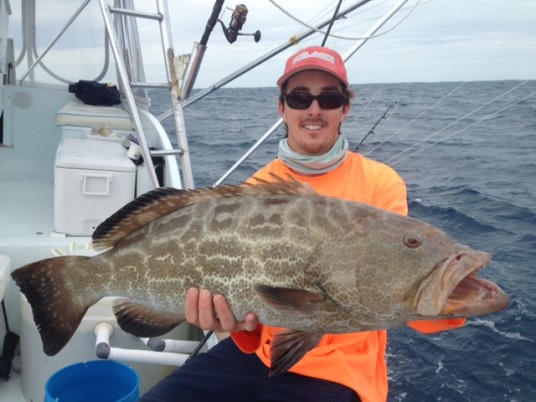
While i was diving on a wreck in 110′ the other day, I came across a big dead black grouper that was half buried in a hole. He hadn’t been dead very long,as he still had color and none of the other reef critters had come to feast on him. I was intrigued by the giant fish half poking out of the hole, stiff as a board, and pulled him out of the wreckage for a closer inspection. Sure enough, he had a big circle hook in the corner of his mouth and a 2′ piece of approximately 50lb leader trailing off. This was one fish that died in battle, but not before he could pull some under-gunned angler’s rig into the wreckage. It was yet another real world reminder that you have to gear up properly for grouper fishing in Miami, FL.
There are several rigs which work well for groupers – most commonly a finder, knocker, or tri-swivel based bottom rig will do the job. It’s important to fish at least 60lb braid with nothing less than an 80lb leader. While you can get away with 60lb flourocarbon, it’s better to be over-prepared than under prepared when it comes to hoisting groupers off the bottom before they can reach structure. Groupers instinctively make a dive for cover upon being hooked, which means you need to use gear that can effectively prevent the fish from running away while not breaking the line. While this dictates the use of heavy main line, leader, and stout hooks that won’t straighten out under pressure (typically 3X strong circle hooks in 7/0 or bigger) – the reel and rod is what will give you the upper hand. You need massive stopping power when it comes to catching big groupers – a drag which can prevent a fish from running into cover can save the day. Make sure you invest in high quality conventional reels in order to maximize drag power. As far as a rod is concerned, you need a blank which is stout and durable – designed specifically for 30 to 50lb class fishing if not heavier. Don’t go overboard here and show up with a tuna stick, but make sure you select a rod which is built specifically to battle groupers and lift them clear of structure which can cut line in a split second.
Why pole when you can troll?
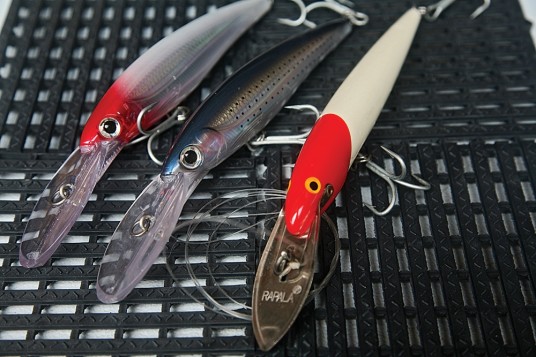
Grouper trolling has become exceptionally popular in Miami. It’s a relatively easy tactic to catch decent size Gag groupers on shallower patch reefs. A standard 50lb trolling outfit will do the job. Make sure you’re using a strong shock leader of approximately 25′ connected by crimps to 100lb ball bearing swivels (use the same outfit you would use when trolling for bull dolphin offshore). Some of the most popular lures for grouper trolling in Miami, FL include Mann’s stretch 20’s, Rapala Magnums, and Yo-Zuri’s in pretty much the largest size available.
It’s best to use one rod when trolling for grouper, unless you’re feeling somewhat adventerous and are confident you can keep the plugs far enough apart as to avoid snagging and wrapping up the lines. We typically troll between 20′ and 30′ of water along the patch reefs, working the sand immediately next to the reefs/rocks which are widely scattered from Fowey Rocks south. Many charter boats enjoy decent success trolling for grouper off Key Biscayne, and will often work their way from Government cut south to Fowey before doubling back. The best practice here is to make sure your lure is just grazing the bottom – the lure should swim as close to the sand as possible, bumping the bottom occasionally but not getting thoroughly hung up. If you snag the bottom occasionally, you’re doing it right. If you’re tolling on the sand, there’s really nothing to snag – if you’re trolling too close to the rocks, it’s likely you’ll lose your lure. Grouper have excellent vision and are pretty quick to dart out and grab a plug – if you’re within 15 feet of the rocks, you’re in the right range. Make sure to cover as much area as you can, typically trolling at 5 to 7 knots the entire time. There’s no mistaking a grouper bite on the troll as they eat aggressively – keep the boat in gear to make sure the fish is clear of the structure then fight as you normally would.
Grouper trolling is an excellent alternative to bottom fishing for grouper if the current is slow and the reef bite just doesn’t seem to be happening. While it’s a bit more expensive to leverage this tactic due to fuel costs, it can certainly help to catch multiple fish in a day by covering lots of ground.
Bait and Switch
Using live bait for grouper is a given. While you can catch them on dead baits like ballyhoo or sardines, there’s just no substitute for a panicking injured baitfish. If we’re targeting groupers specifically on a trip, we will bring a selection of baits to make sure we can offer a wide menu. We find that pinfish, goggle eyes, and big pilchards work best for grouper in the summer months, but grunts and blue runners are a close second. Bridling bottom baits is a must as groupers tend to engulf their prey rather than bite it. A bridled bait will set much more effectively in the mouth of a big fish and there’s less chance of the hook tearing out of the bait upon impact.

If you’re anchored up on an area and the grouper bite is consistent, you might consider tossing a few chunks into the water to get fish fired up while vertical jigging. Cut baits settling to the bottom will bring groupers out of their hiding spots and can put them in proximity to your live baits. Chunking also brings all kinds of other species into the fold, which can be an added bonus. While chunking, we’ve been known to drop a vertical jig and work the bottom with great success. Vertical jigs are excellent for grouper if you’re anchored, as the appearance of the jig bouncing a few feet off the bottom then fluttering back down provides an excellent presentation. Don’t hesitate to switch up the baits you’re using while fishing for grouper in a specific area (i.e. at anchor) – use frisky live baits as much as possible but switch it up to jigs tipped with dead bait every once in a while. You might just be surprised at the results.
Don’t Discount the Drag
This is the one mistake that most grouper fishermen make. Using heavy drag means more pressure on you, but it’s necessary to prevent fish from diving into the bottom structure. Most of the serious groper fishermen I know fish heavy tackle with locked down drags – preventing fish from gaining even an inch. Often they will drop baits to the bottom and keep the line completely slack so they can feel the bite, then wind tight and hold on with all their might. That first engagement in battle with a grouper is punishing, but you only have a few seconds to get them clear of the bottom structure or you will lose the fish. If you’re fishing heavy gear, you don’t have to worry about breaking the line – only pulling the hook. If you’re using circle hooks, it’s very unlikely the hook will pull. Your best bet is to fish with a locked down or almost locked down drag – putting maximum pressure on the fish at all times. If you can get a grouper clear of the bottom, your chance of landing the fish is much much stronger. Take a “no mercy” approach when it comes to applying drag pressure for groupers – just make sure your tackle can withstand the stress of the bite and fight.
